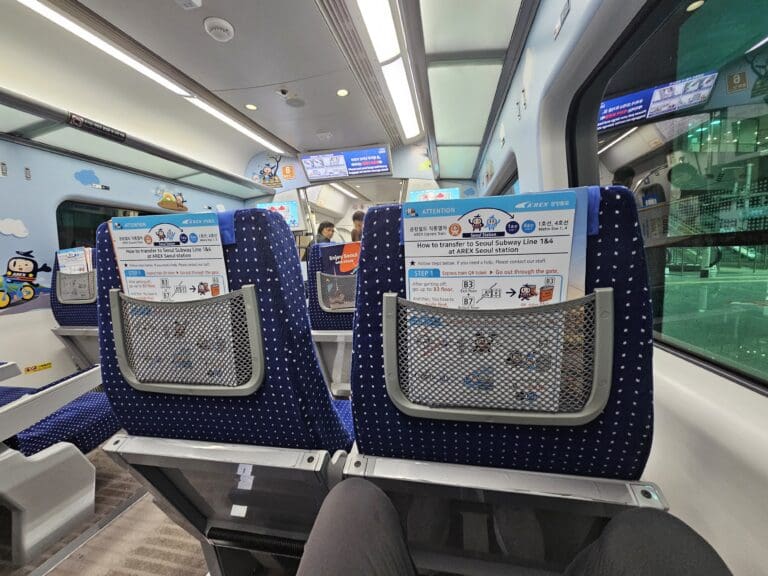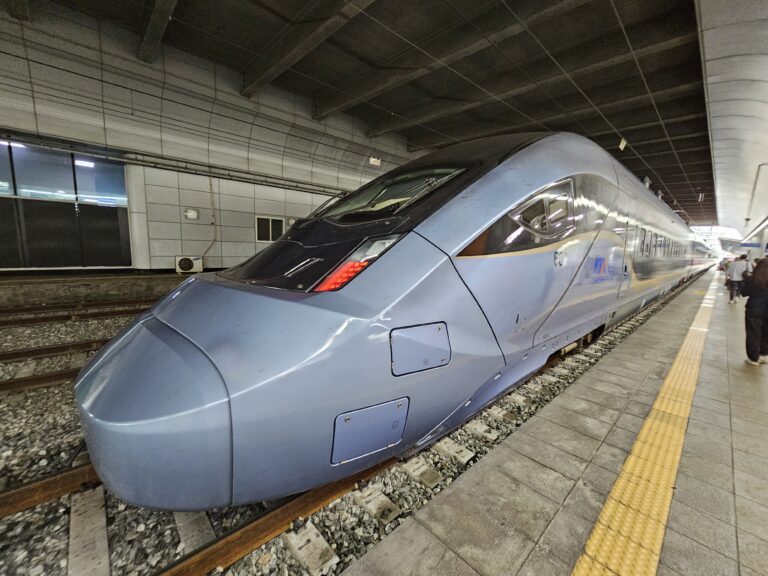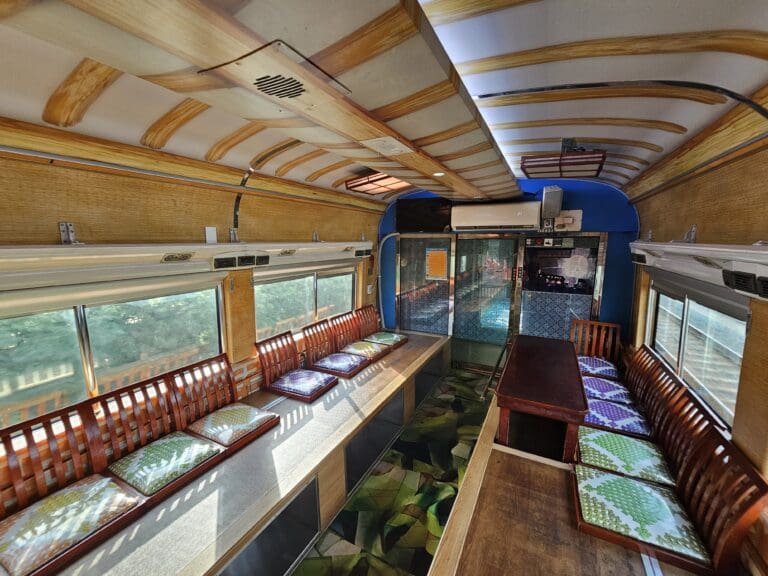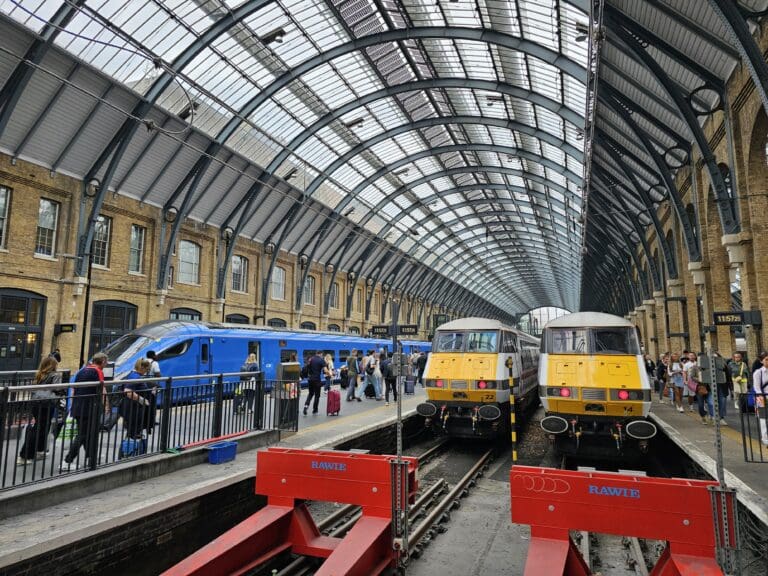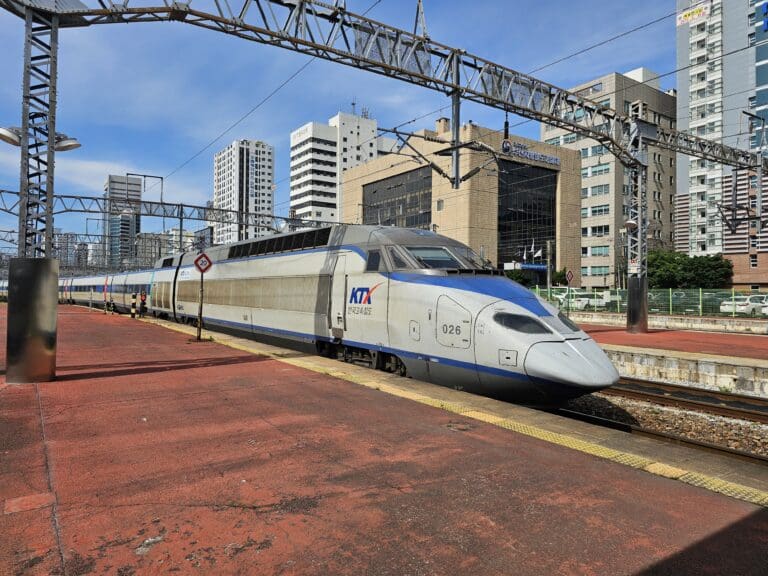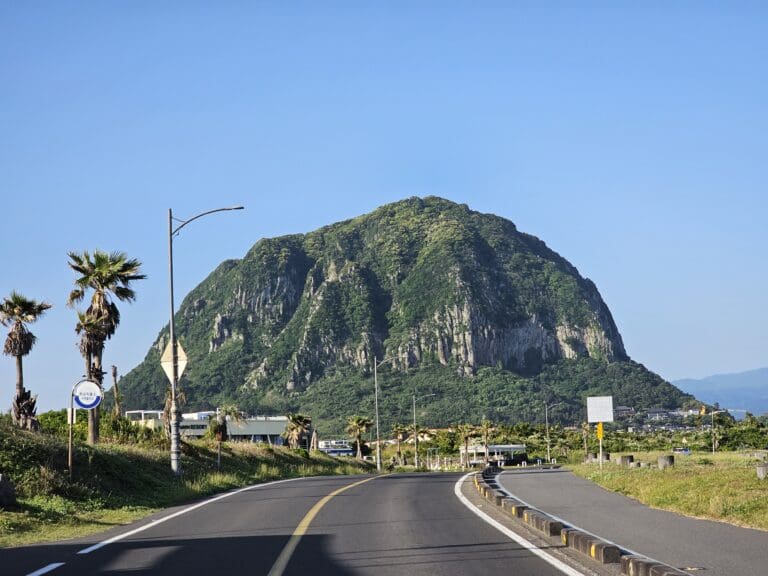A High Speed Rail Journey in Uzbekistan: Sampling the Afrosiyob
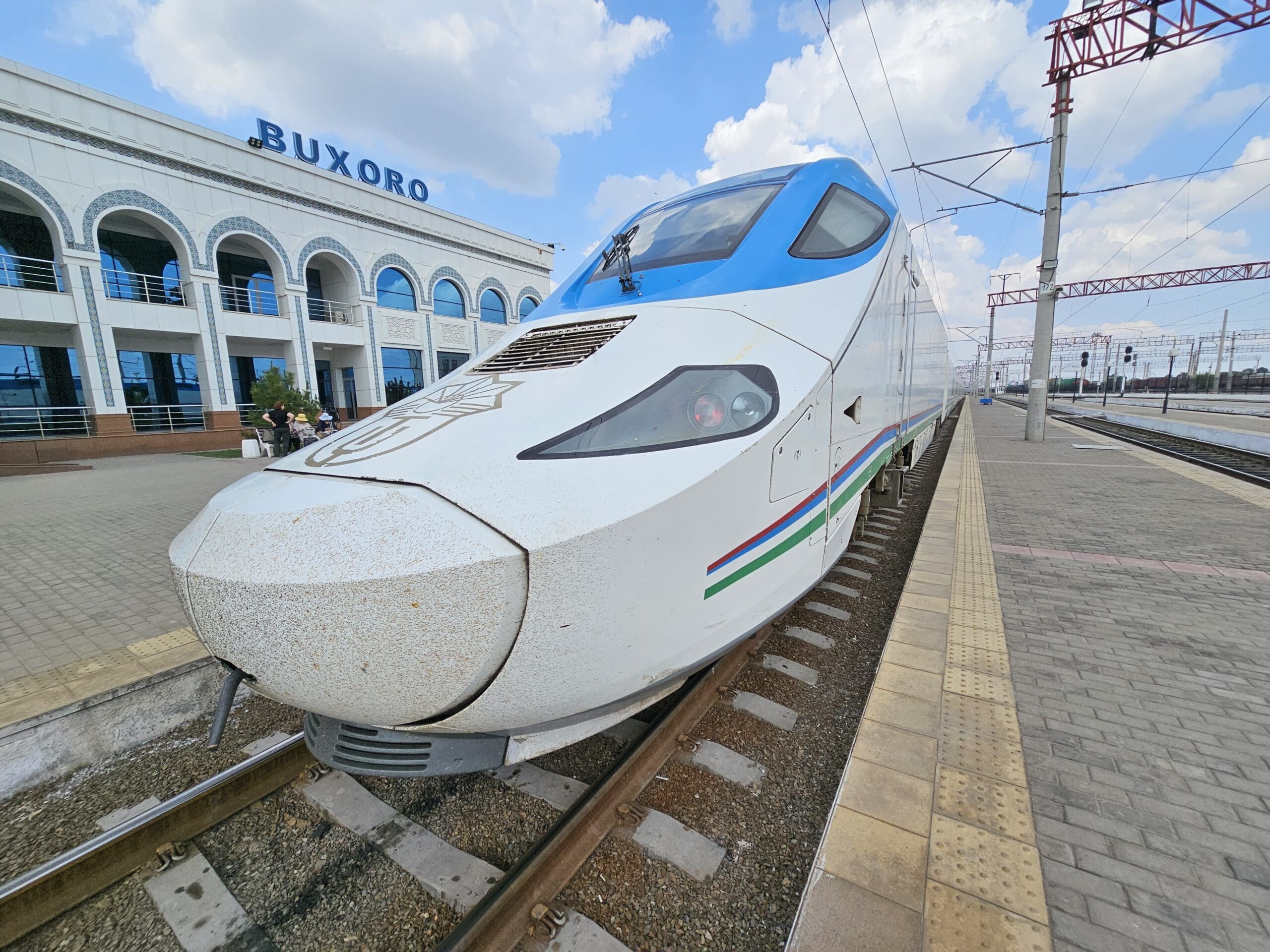
Travel Around Uzbekistan
Located in the heart of Central Asia, Uzbekistan is a relatively large country that is comparable in size to the likes of Morocco or Sweden. Given the vast distances that separate many of the country’s towns and cities, trains have long played an important role in Uzbekistan’s transportation infrastructure and today the country is home to almost three thousand miles of railway lines. The pride of this is undoubtedly the high-speed line which connects Tashkent with the cities of Bukhara and Samarkand and is eventually set to run all the way to Khiva. Each day, Spanish-made Talgo 250 trains hurtle up and down this line at speeds of up to, you guessed it, 250 km/h (155 mp/h) on Afrosiyob services. Whilst arguably less characterful than the old Soviet-era sleeper carriages, these trains provide a relatively quick and easy way for tourists to travel between some of Uzbekistan’s key Silk Road sights.
Needing to get from Bukhara to Tashkent, and seeing as I would be taking a sleeper train on the outbound leg (you can read my review of this here), I decided to return to the capital city onboard Uzbekistan’s exciting high-speed trains.
Booking
Once upon a not-too-distant time, those looking to travel on trains in Uzbekistan either had to queue up at the small window of a station’s ‘kassa’ or reserve these through a locally based agent. However, today purchasing tickets for state-owned operator Uzbekistan Railways’ services can be done quickly and easily through their website and most tickets are released for sale 45 days prior to departure. Given the popularity of the Afrosiyob, it is advisable that those looking to travel on these services book tickets for these as soon as possible as these do frequently sell out – especially those running at peak times. However, tickets can also be reserved further in advance by enlisting the assistance of a local tour company although those that go for this option often end up paying a significant premium to do so.
Not experiencing any issues with Uzbekistan Railways’ modern website, I decided to utilise this to purchase tickets for both legs of my Uzbek rail adventure. Focusing on my journey on the Afrosiyob, exactly 45 days prior to departure I made a search for trains and was surprised to find that just one seat remained for sale on the entire train! This came in the form of a seat in the most luxurious portion of this three-class train, the 11-seat VIP carriage. Priced at a total of 326,000 Uzbek S’om (£22/€26/$28), this paled in comparison to almost any ticket onboard an intercity service back in the UK, although it was, as you would expect, significantly higher than a seat in Economy (171,000 S’om) and Business (236,000 S’om). Eager to complete the purchase and secure my ticket as soon as possible, I was then taken to the seat selection page, where unfortunately it revealed that this last remaining seat. Although beggars can’t be choosers and so I went ahead and selected this before making a quick and easy purchase.
To start, here are some photos from Bukhara
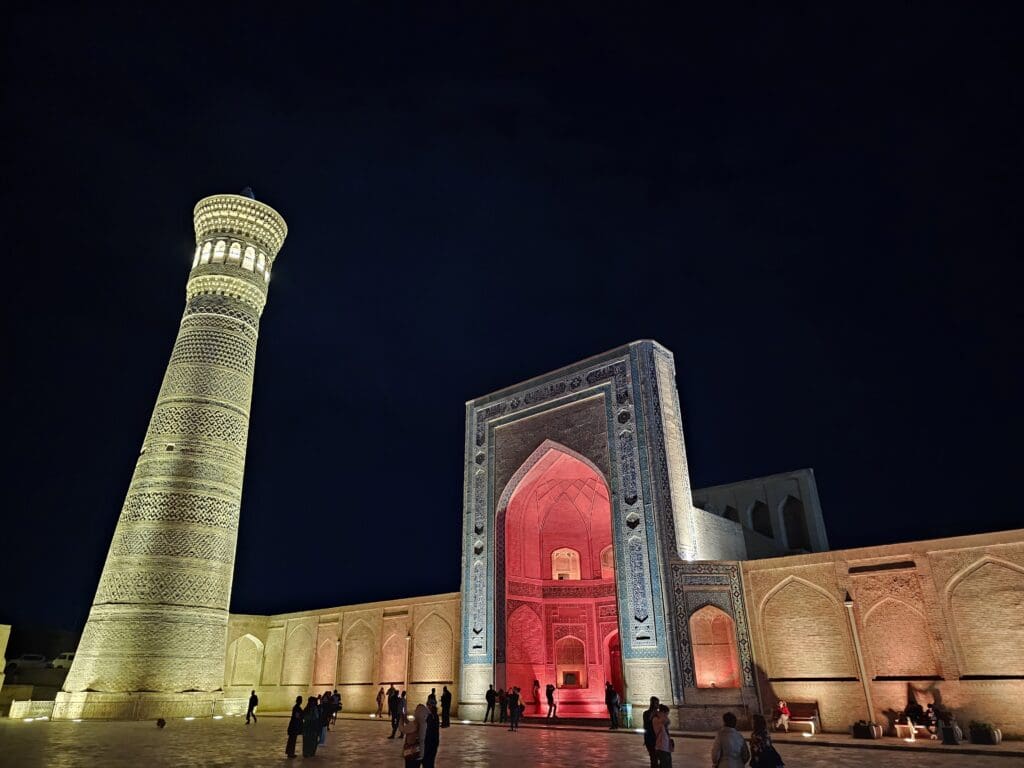
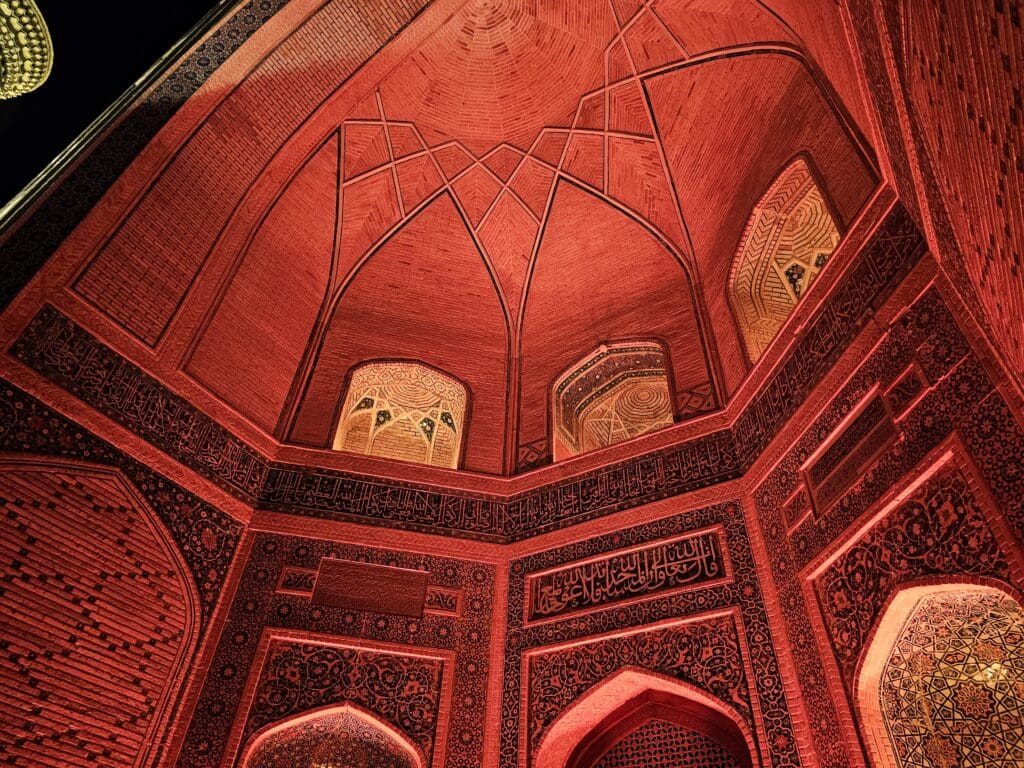

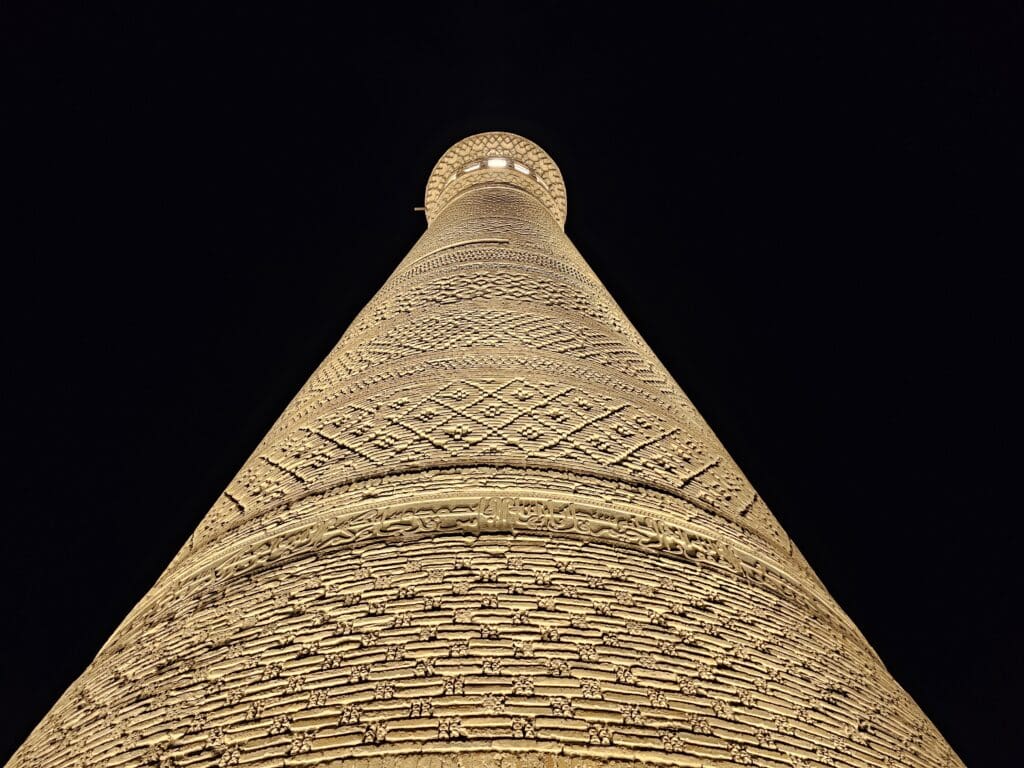
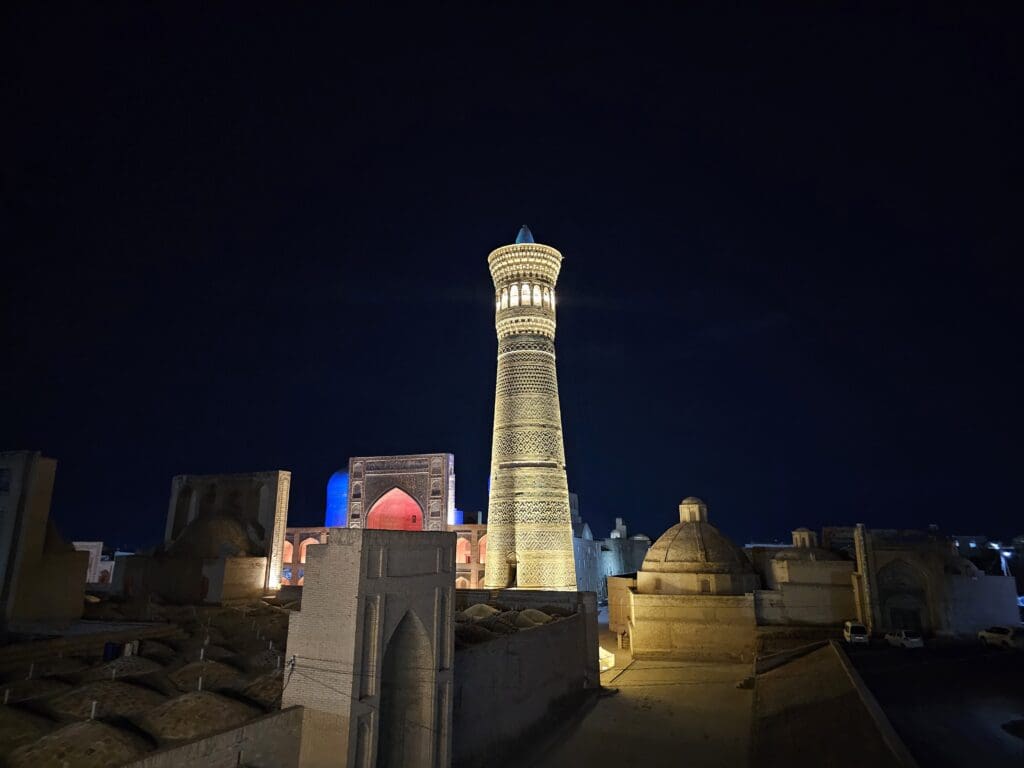
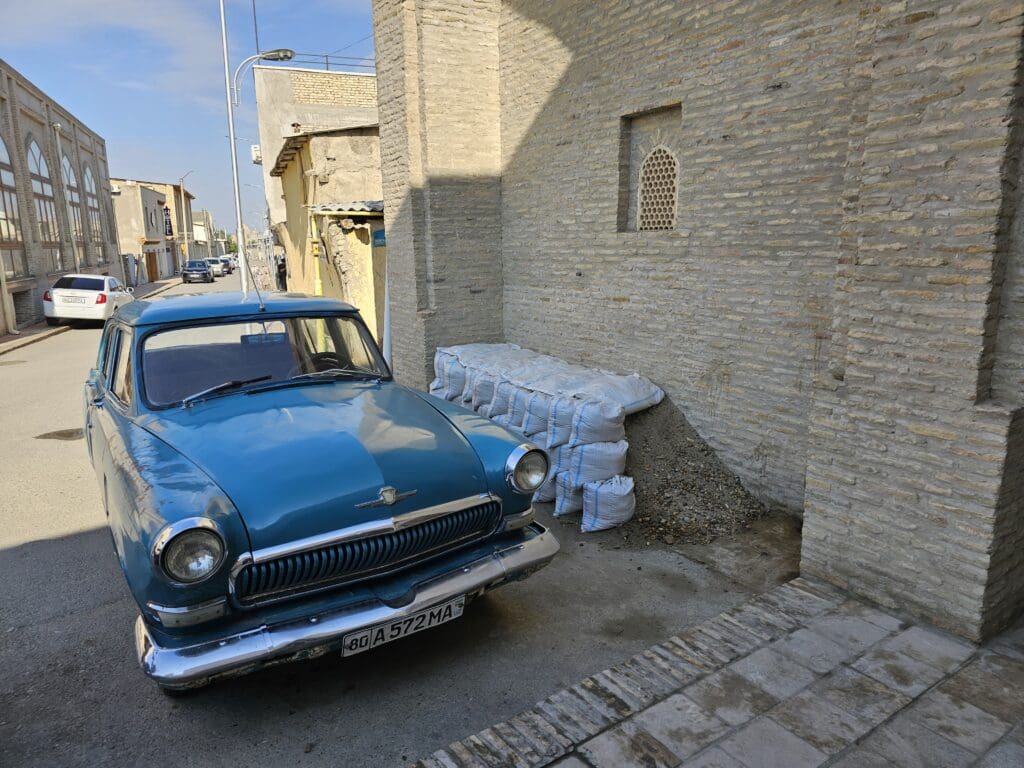
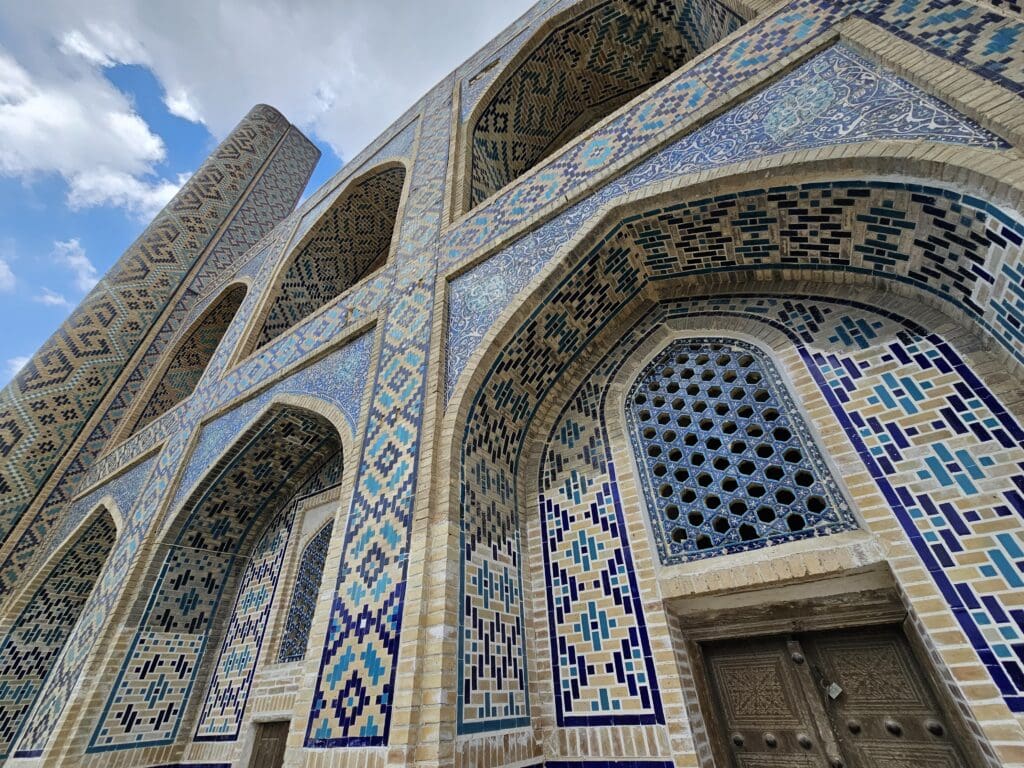

The Journey
Following the best part of a weekend in Bukhara, it was time for me to wend my way back to Uzbekistan’s capital city. However first, I would have to reach Bukhara-1 Station which is located outside of the city in the neighbouring town of Kogon, approximately fifteen kilometres from the centre of Bukhara. Unfortunately, my stay in Bukhara had not gotten off to the best start. Arriving at Bukhara-1 station in the middle of the night, my hotel-arranged taxi failed to appear at the station and I was thus left with little choice but to be ripped off by the station taxi touts and ended up parting with nearly $20 to ride at worryingly high speeds down Bukhara’s bumpy roads. Whilst it had not worked the first time round, I decided to give the hotel-arranged taxi another shot given the fact that this would only cost me $6 (not amazing but a good deal for a tourist) and pre-booked this for 1345, an hour and a half before my train’s scheduled departure time.
Following one last morning walk around Bukhara before things got a little too warm, I returned to the hotel and to my delight, the driver could already be seen waiting and engrossed in a cup of tea and some deep conversation with the receptionist. Once they had finished this, I was taken outside to their old, battered and seatbelt-less car, and soon we went hurtling down the narrow and bumpy streets of the old town. After joining the dusty main road, the driver seemed to fancy themselves to be somewhat of a boy racer as we weaved in and out of traffic on the journey out of the city and towards the neighbouring town. Around fifteen minutes after leaving the hotel, Bukhara-1’s grand and relatively modern station building appeared with its many shining and well-polished windows, and large Uzbek flag that could be seen waving high above. In front of this stood a small park complete with a fountain, providing passengers with a nice place to wait prior to their journey.
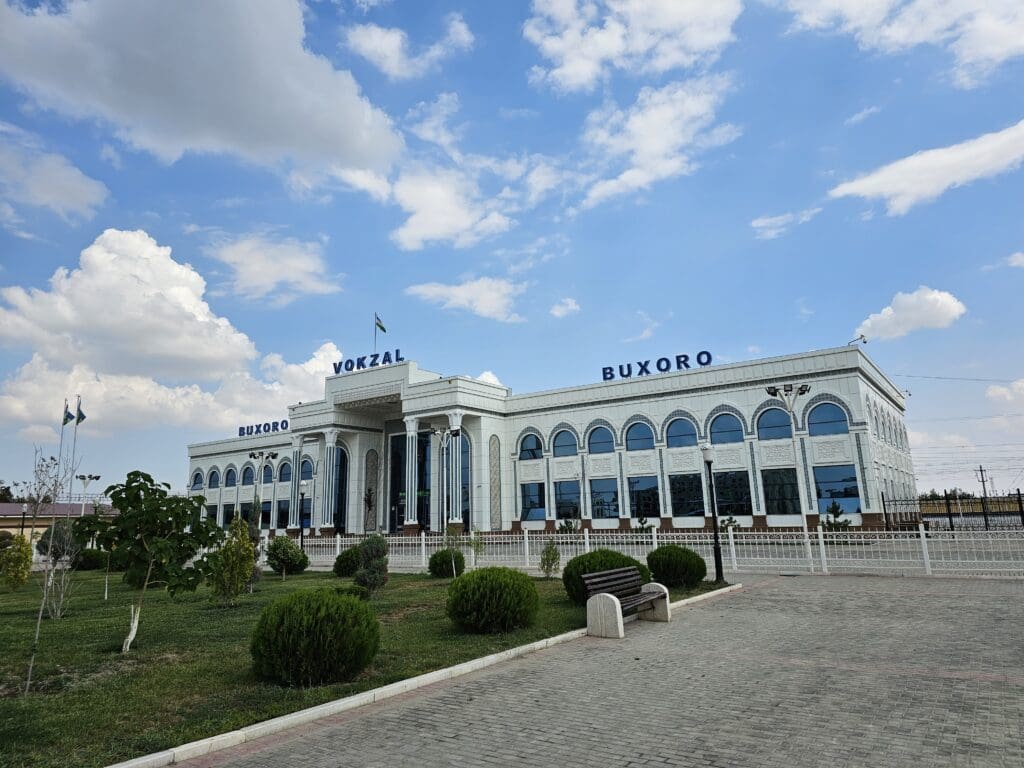
After thanking the driver and stepping out of the car, I made my way towards Bukhara-1’s grand station building and as with most of Uzbekistan’s airports and train stations, only those with a ticket were permitted to enter. Upon entering this, I passed through a security checkpoint where my bag was sent through an x-ray machine before I made my way through a metal detector and into the waiting hall. Left with around an hour to go until departure, and with no other trains set to depart until the 1515 service to Tashkent, at this time the station was already fairly busy and a constant trickle of passengers could be seen arriving for the duration of my stay. Inside the station, a few kiosks (all bar one of which was closed) and a restaurant could be found, and whilst not the most exciting place to wait, I was pleased to find this to be pleasant and clean. However, unfortunately, those wishing to connect to a wifi network or charge their devices would have been out of luck, with neither of these being available.
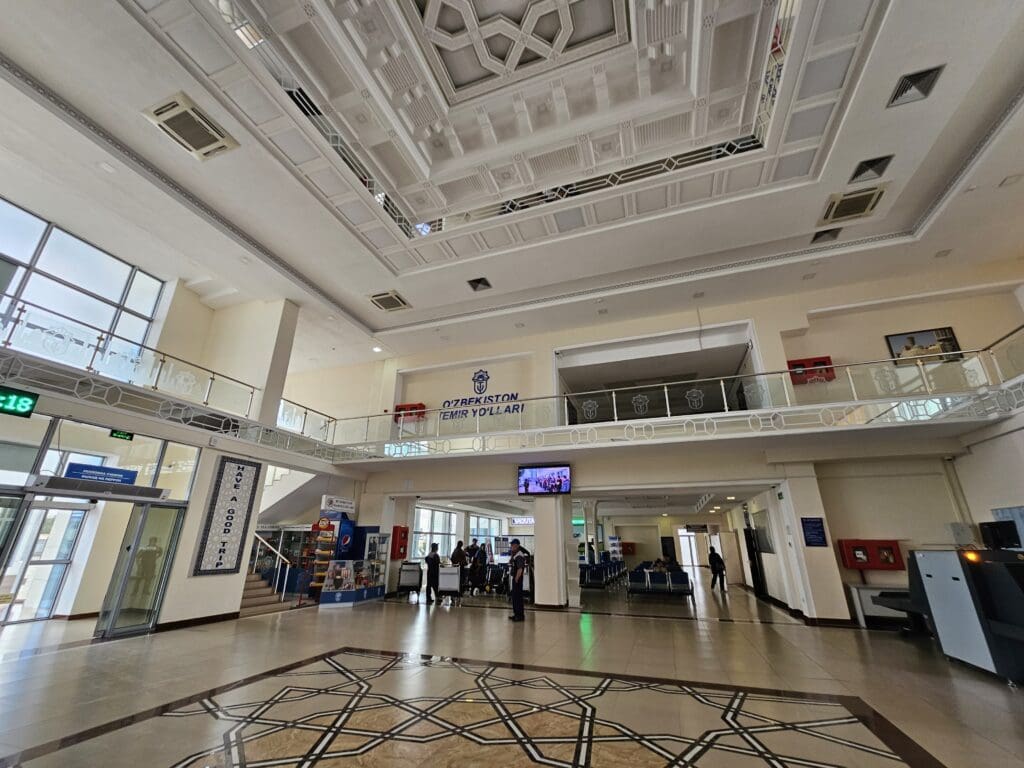
With passengers free to wander about, not wanting to spend the entirety of my afternoon inside I made my way out onto the platform where I caught my first glimpse of the sleek train that would be taking me over to Tashkent. As I walked up and down the platform, I counted the train to consist of a grand total of eleven passenger carriages, most of which housed the train’s Economy class, along with one for Business and a half-carriage for the VIP class section at the very rear of the train (the other half of this carriage appearing to contain staff facilities and a kitchen. Whilst until relatively recently Uzbekistan was not the best place for those looking to photograph anything infrastructure related, the many military-esque security guards and Uzbekistan Railways staff on the platform did not appear to take issue with the many passengers taking photos of the train prior to departure. Glancing around, that afternoon whilst as expected most passengers hailed from Uzbekistan, large groups of French, North American and Russian passengers could be seen on group tours.
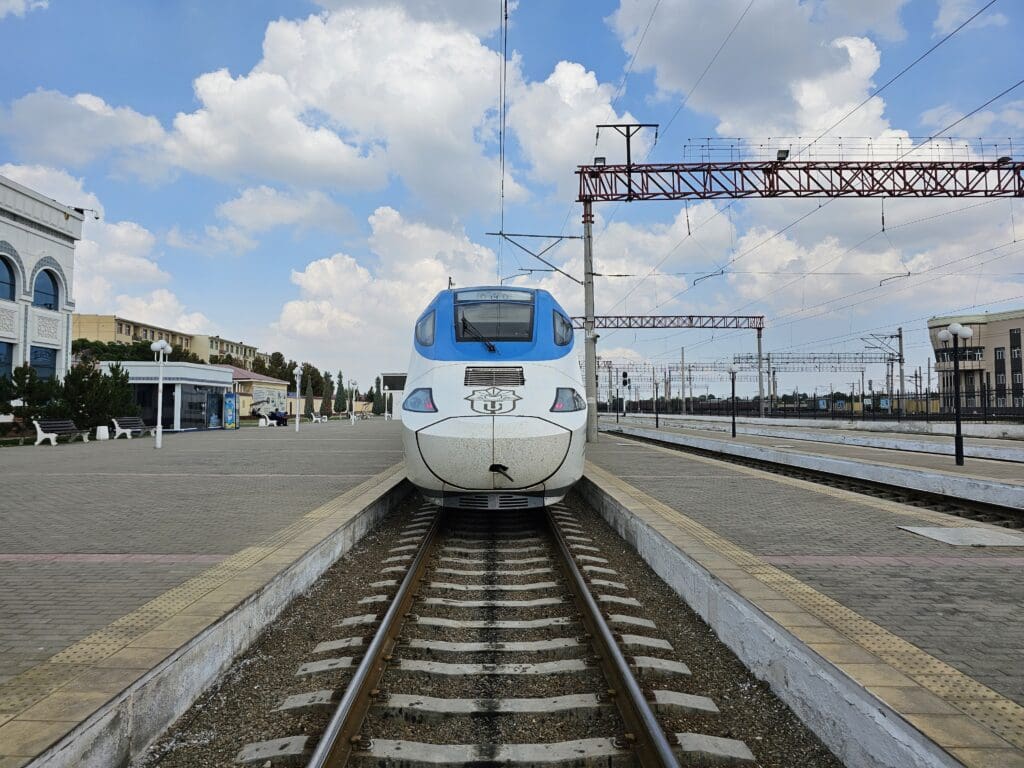
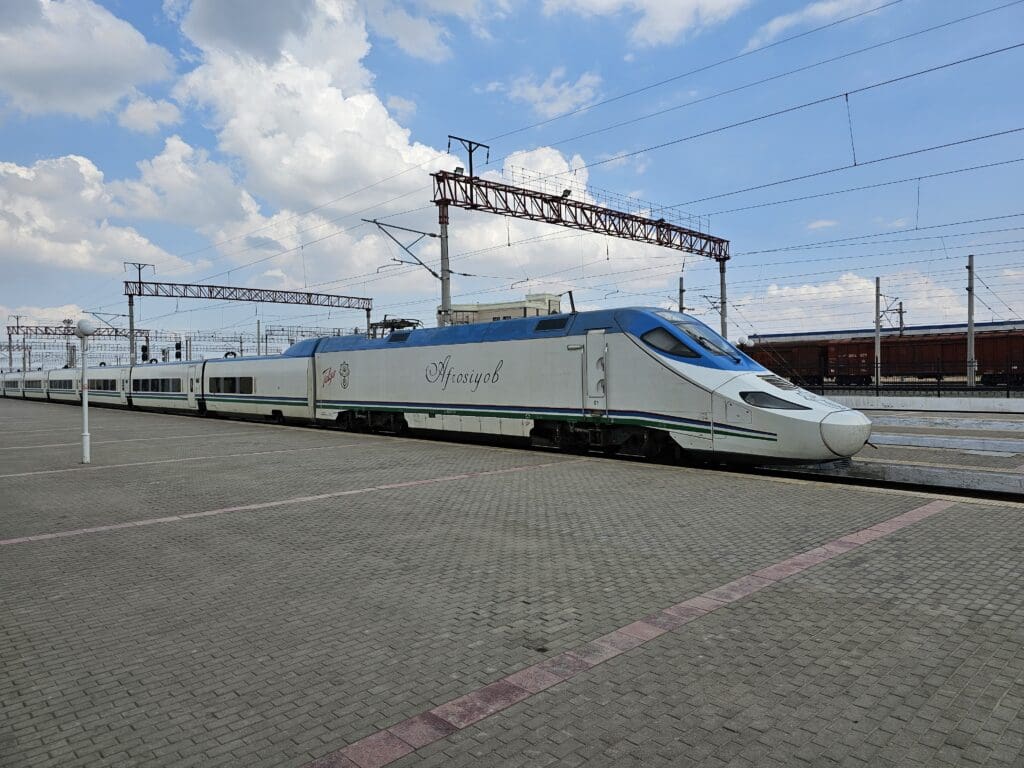
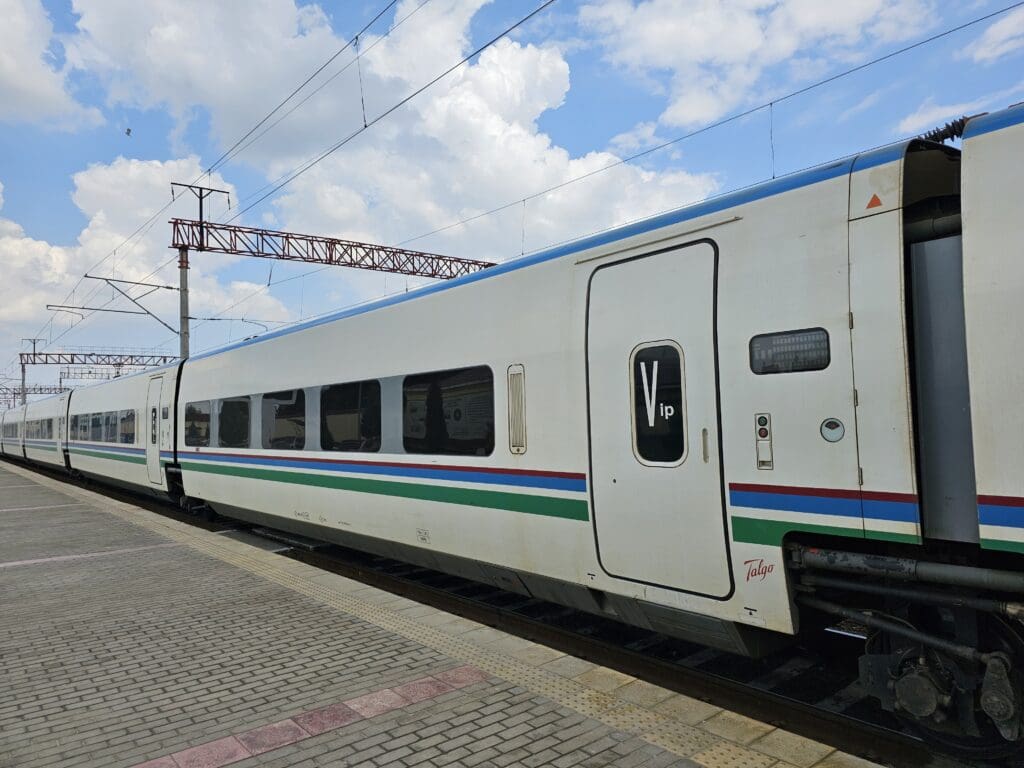
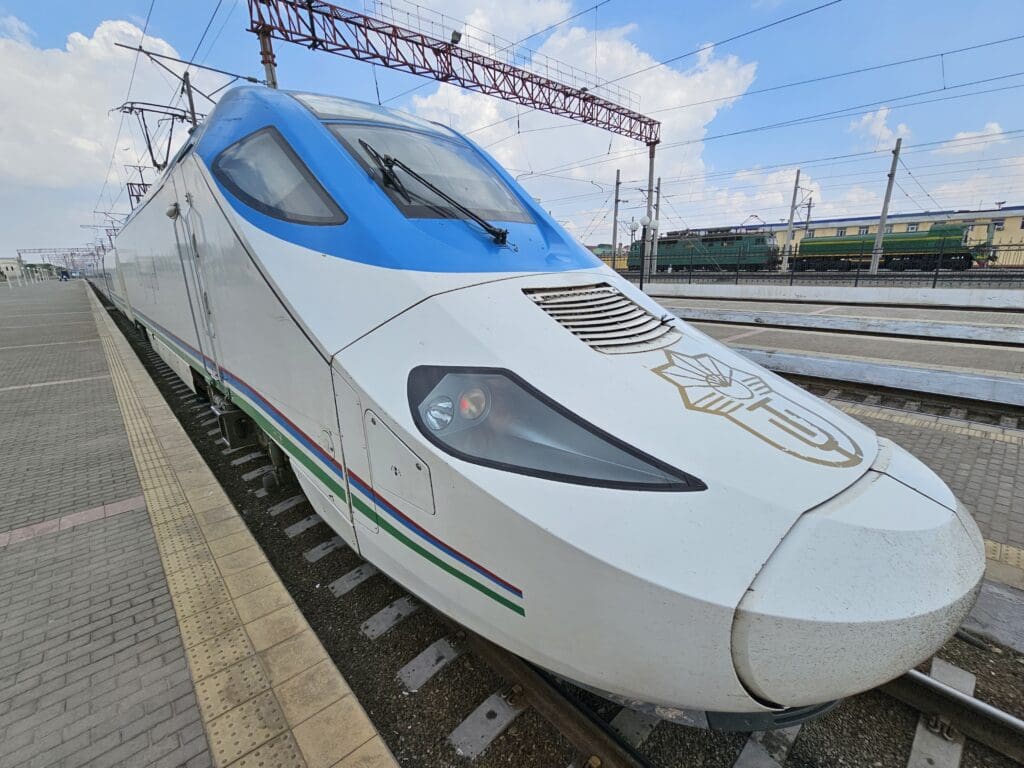
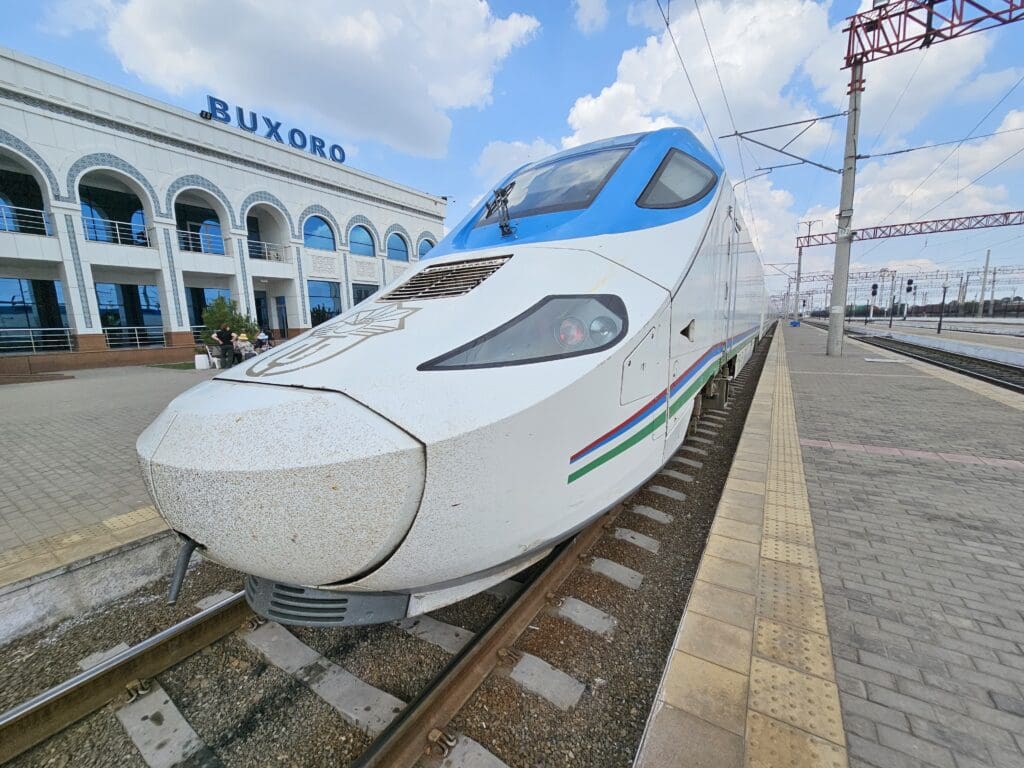
With sixteen minutes to go until departure, the Afrosiyob staff dressed in a slightly more modern and civilian uniform than their ‘normal’ Uzbekistan Railways counterparts took to the platform at which point boarding commenced. Just before stepping onto the train, the VIP Class attendant gave me a warm welcome in Russian and after showing my ticket I was allowed to step onboard. After passing through the spacious vestibule and luggage storage area, I entered the small VIP cabin. Inside, this consists of a total of 11 large leather seats in a 2-1 configuration, each of which sported a disposable fabric antimacassar. All of these face one another, and so if you are travelling solo it is very likely that you will end up with someone sitting directly opposite you. Onboard, each table was covered in a fabric tablecloth with a plastic protective cover over the top of these, on which an Afrosiyob branded tissue box, packets of disposable headphones and Russian language newspapers could be found. Each seat came complete with an audio control panel, plug socket and reading light and upon sitting down I found this to be highly comfortable and well padded, whilst also spotlessly clean with no sign of any wear and tear. In addition to overhead screens which broadcast advertisements, government videos and other short clips on various things throughout the journey, a panel could be found at the end of the carriage advising passengers on the train’s speed, and the date and outside temperature.
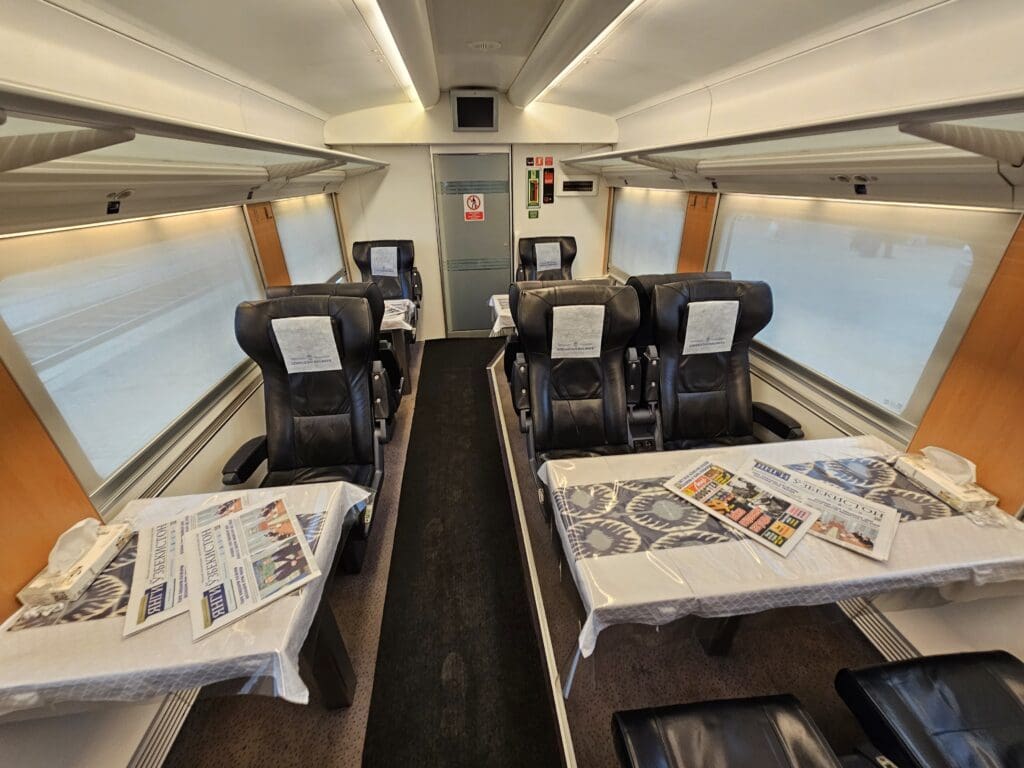
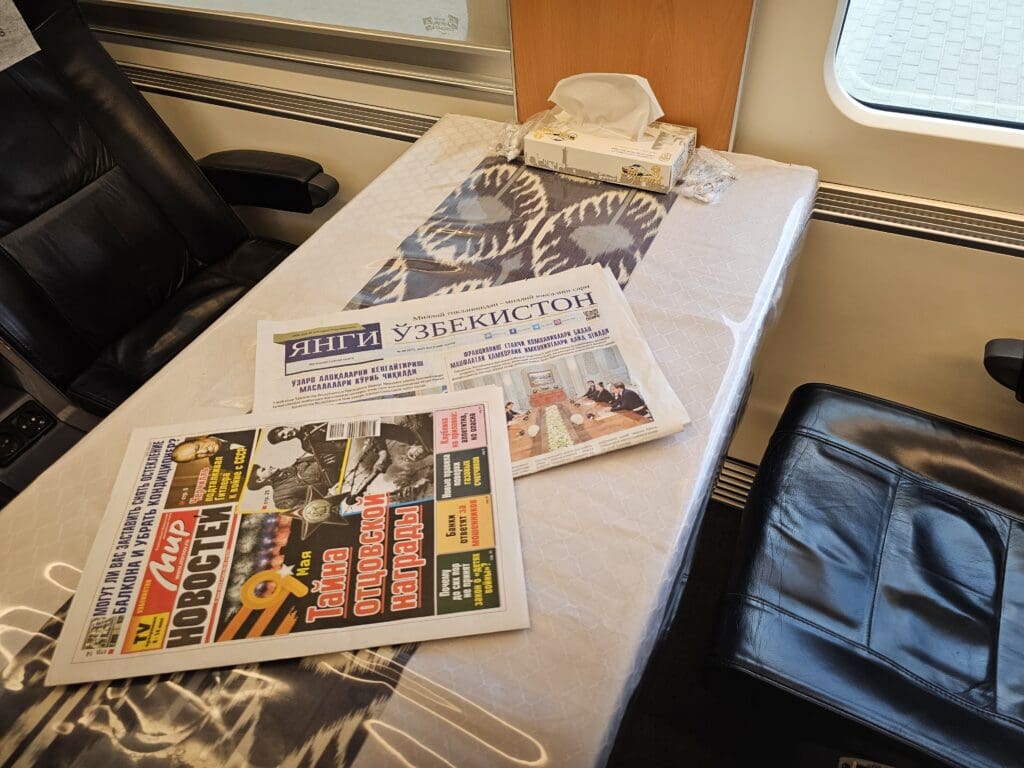
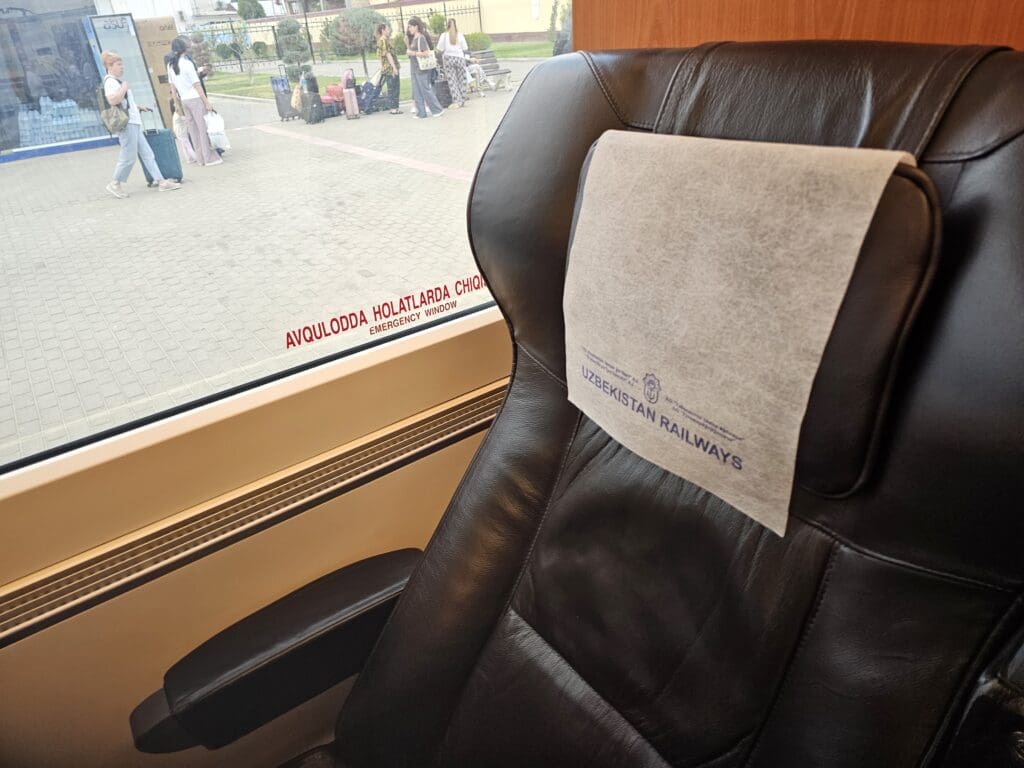
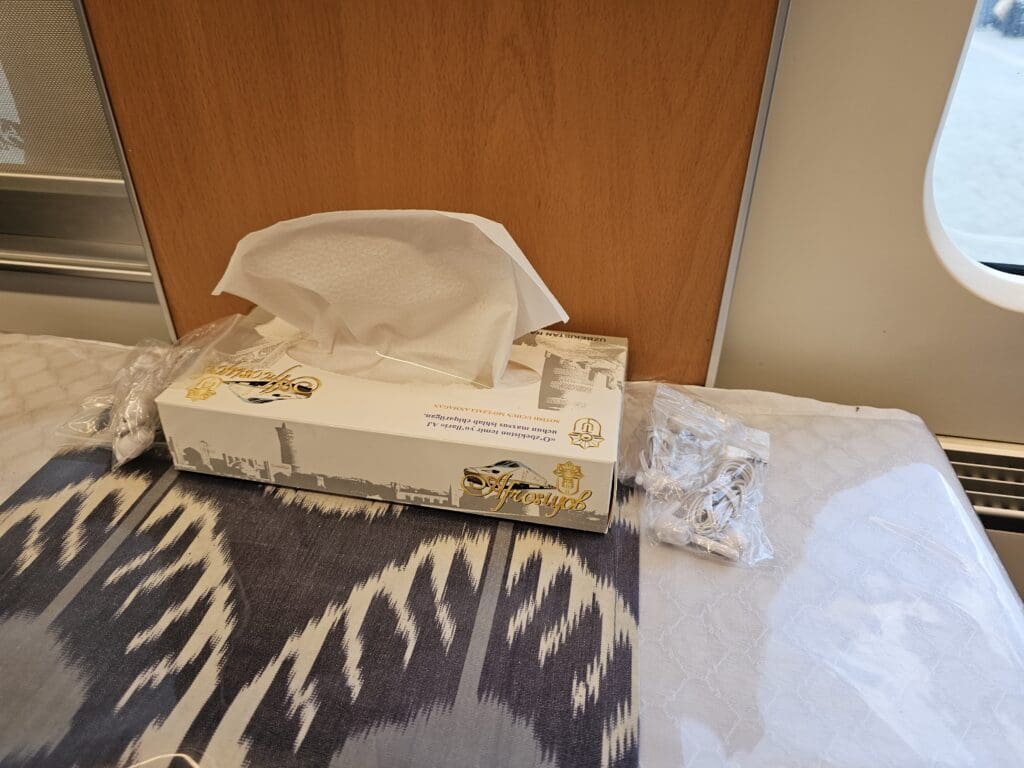
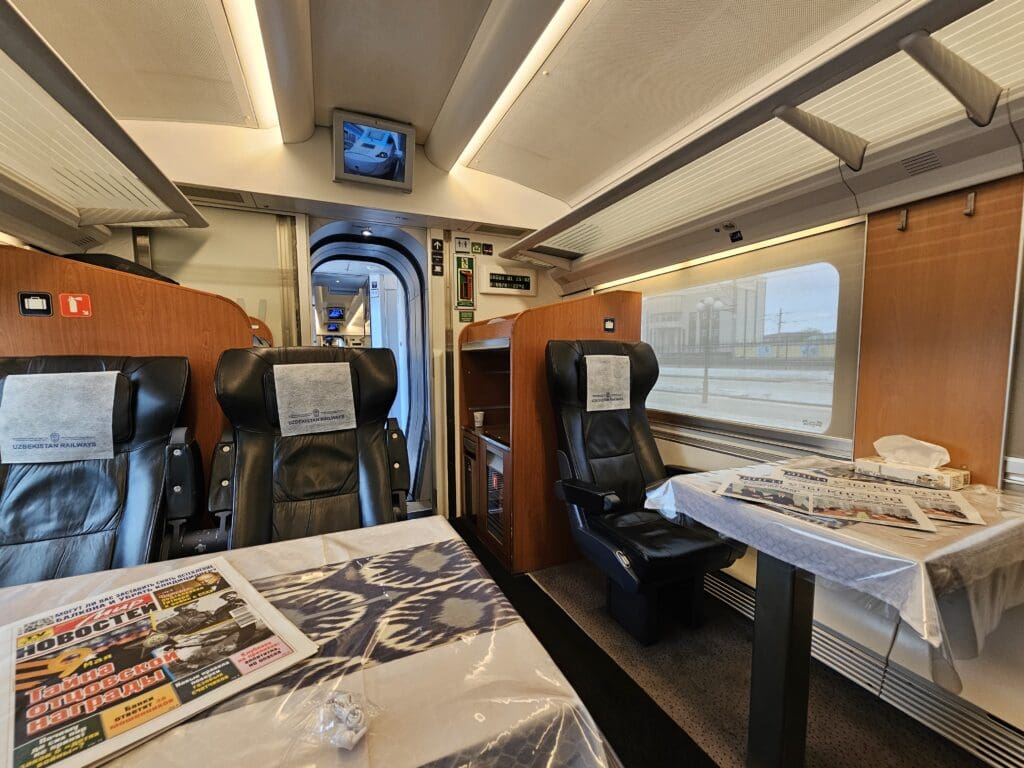
Once sat down, it wasn’t long before I was joined by several other passengers with this section ending up around half full for the initial hop over to Navoi. That afternoon, I was the only foreigner in this part of the train and was severely underdressed compared to my very smart-looking fellow passengers. After three minutes following our scheduled departure time had passed, the train doors closed and a short time later the Talgo train accelerated away from Bukhara-1 Station, passing the nearby freight yards before leaving the town of Kogon behind. At this time, the flat green agricultural landscapes that surround the city came into view although these did not last long and were soon replaced by arid and dusty scenes with little sign of life. Seeing as nobody was sitting in the window seat across the aisle, I decided to move across to this until our first stop.
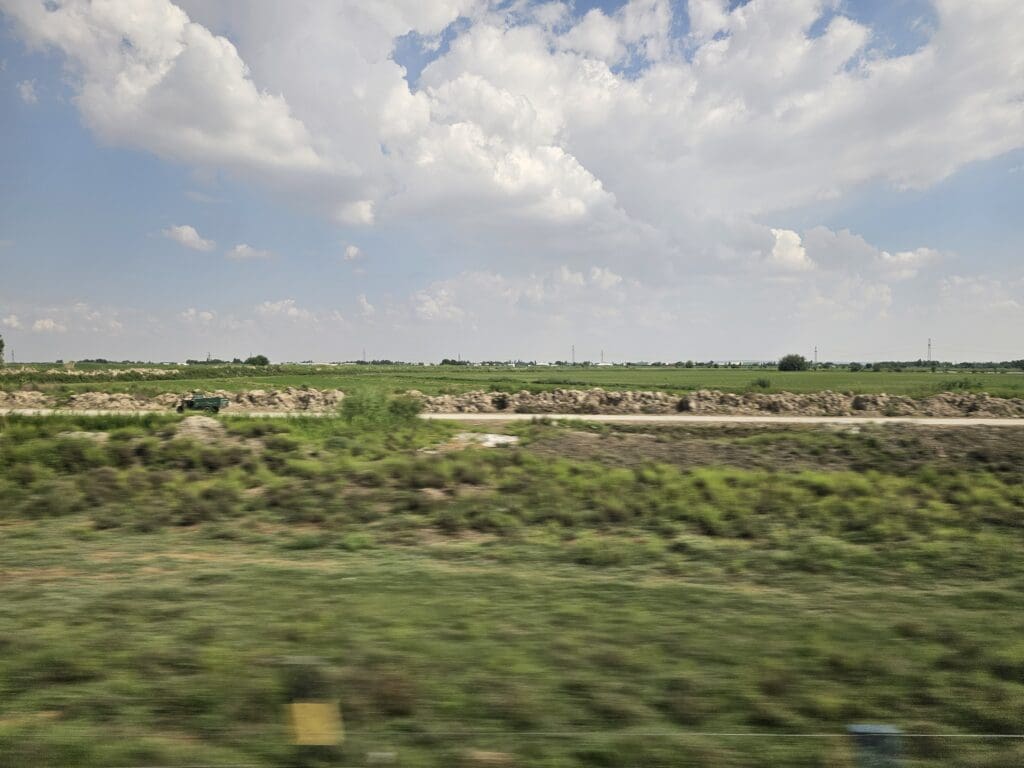
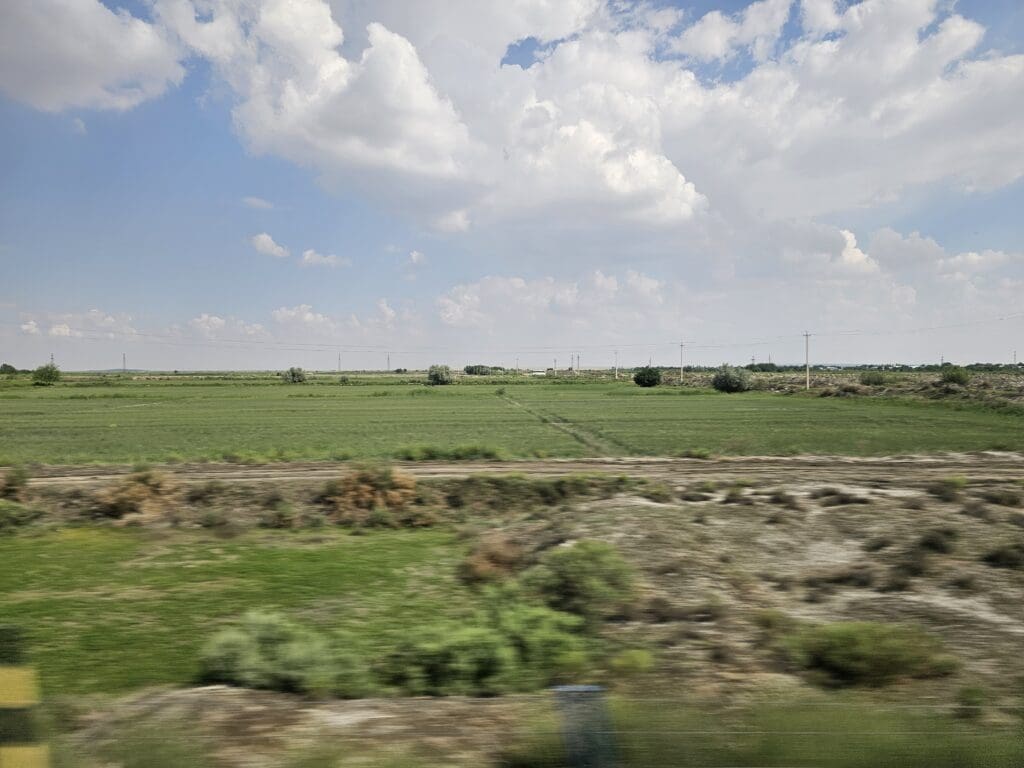
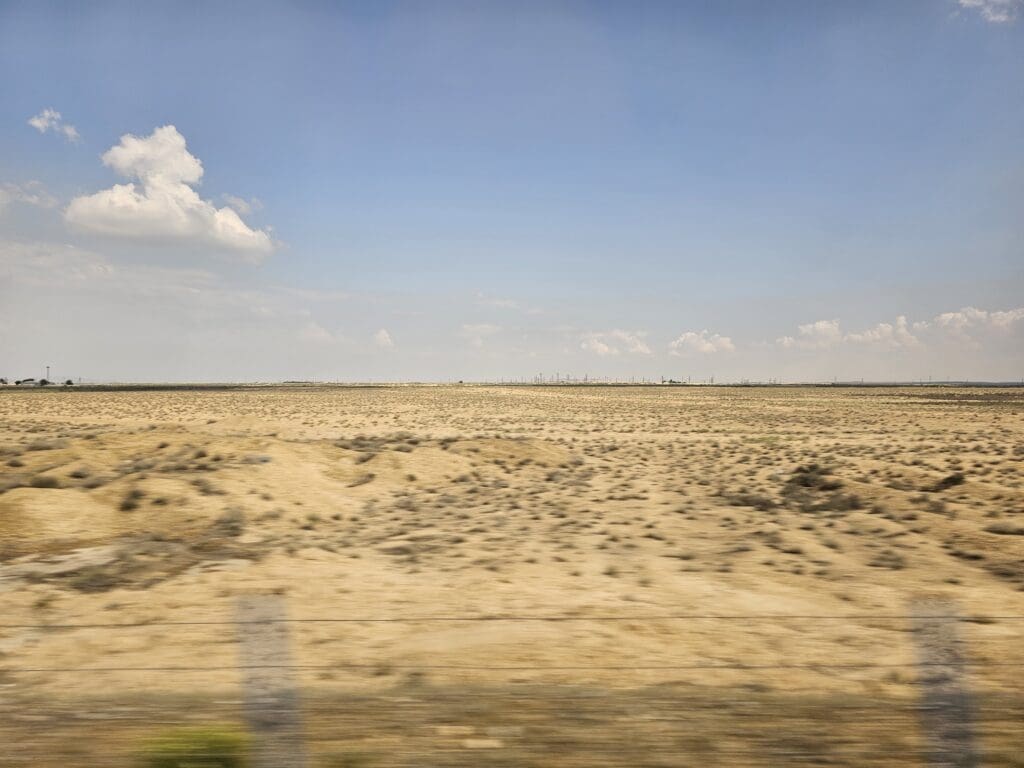
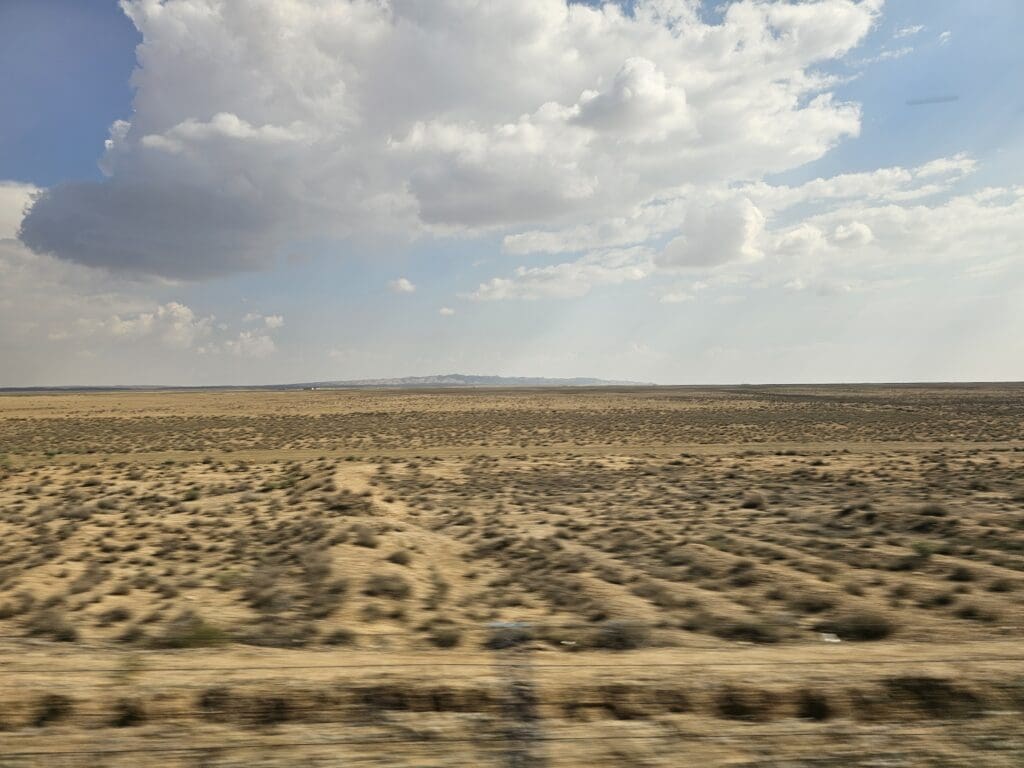
Inside the train, two attendants appeared around fifteen minutes into the journey and commenced the first round of VIP service – politely offering passengers tea or coffee. Opting for the latter, this was soon poured out into an Uzbekistan Railways paper cup and cautiously placed on the table in front of me. As I sipped this, the train slowed down as it passed through the small town of Qiziltepa which sits around halfway between Bukhara and Navoi. Once we were past a freight yard, the train picked up speed once again and we found ourselves in the midst of the arid plains of Uzbekistan. There, very little could be seen save the odd house and old tractor chugging along.
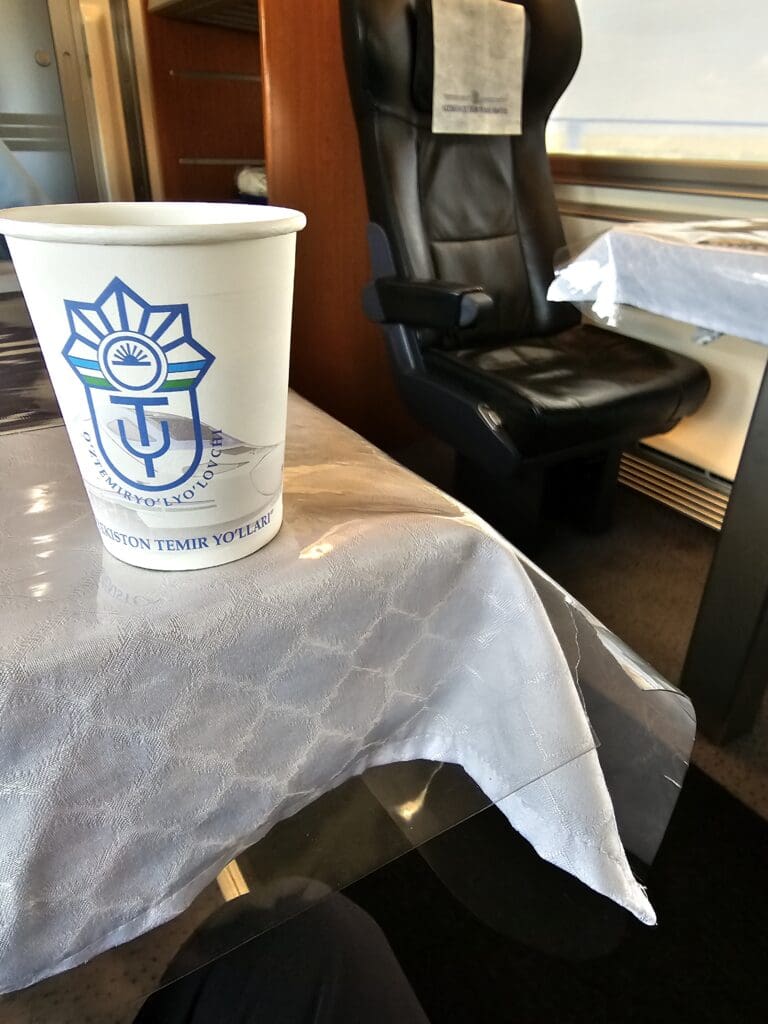
Around forty minutes into the journey, hills could be seen rising up in the distance to the south and soon we passed through what seemed to be a gigantic chemical plant. Almost immediately afterwards we reached the outskirts of Navoi at which point the train decelerated and a pre-recorded announcement rang out in Uzbek, Russian and English advising all passengers of the impending stop. Coming to a halt at the city’s small station just after 1600, it was here that the small VIP section filled up leaving me with no choice but to return to my original aisle seat. A short time later, the train continued on its journey, soon leaving the city behind. With little to see from my aisle seat as we sped through the plains of Uzbekistan, I drifted off to sleep temporarily waking up just in time for the second drinks round which once again consisted of coffee and tea.
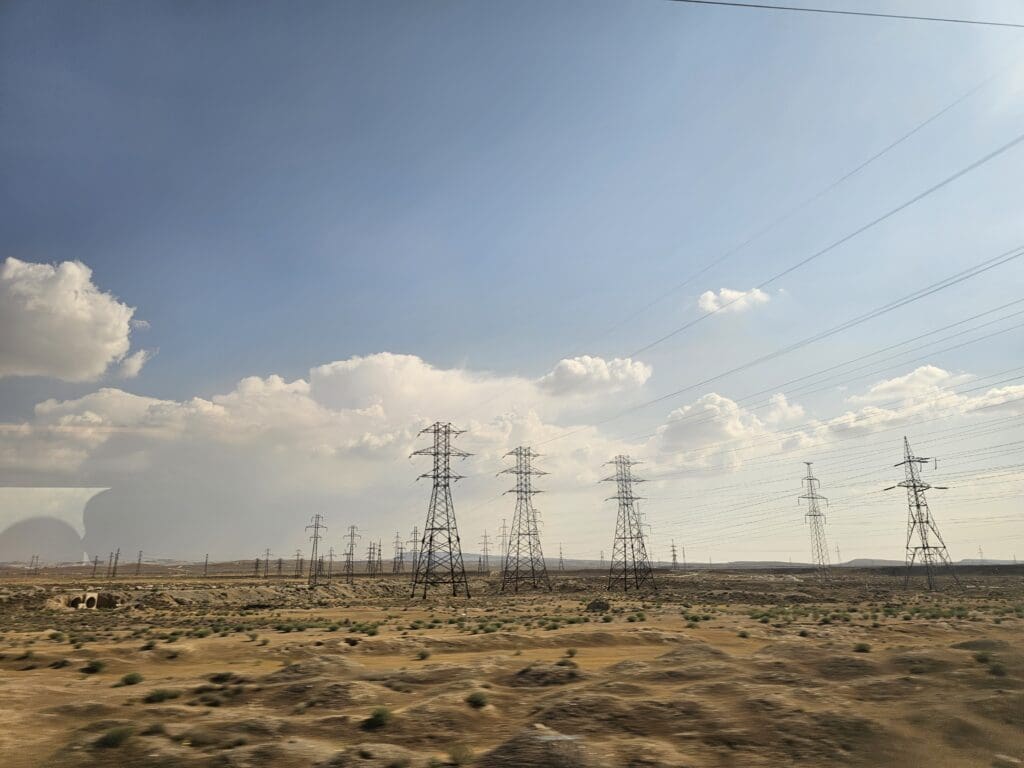
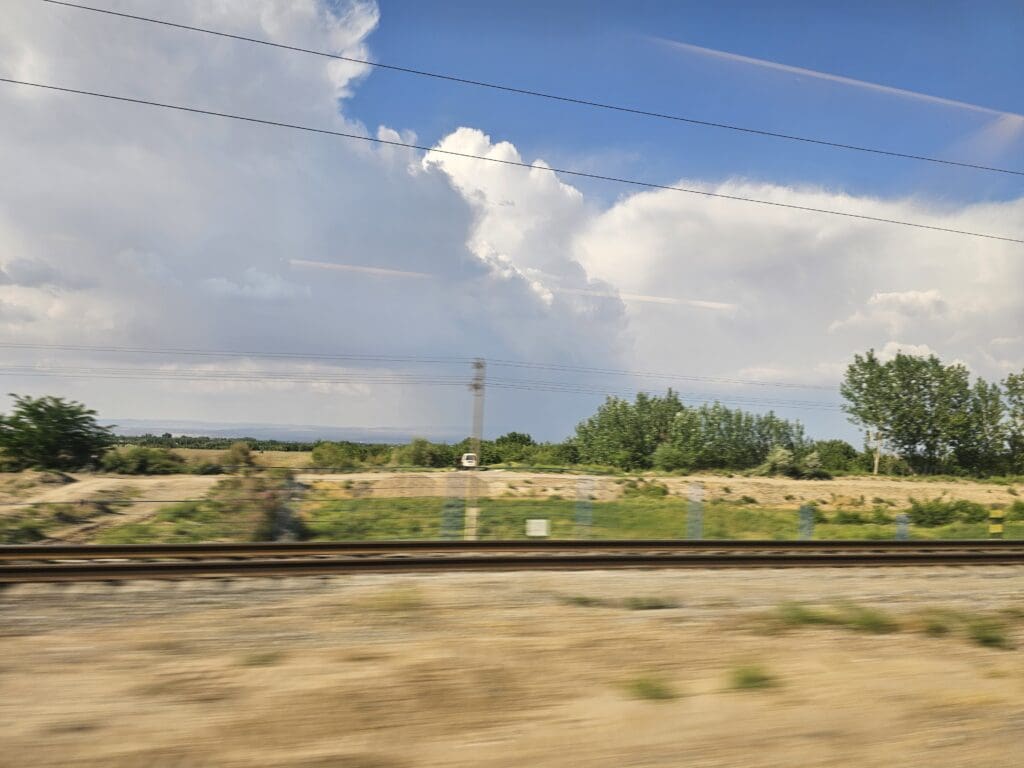
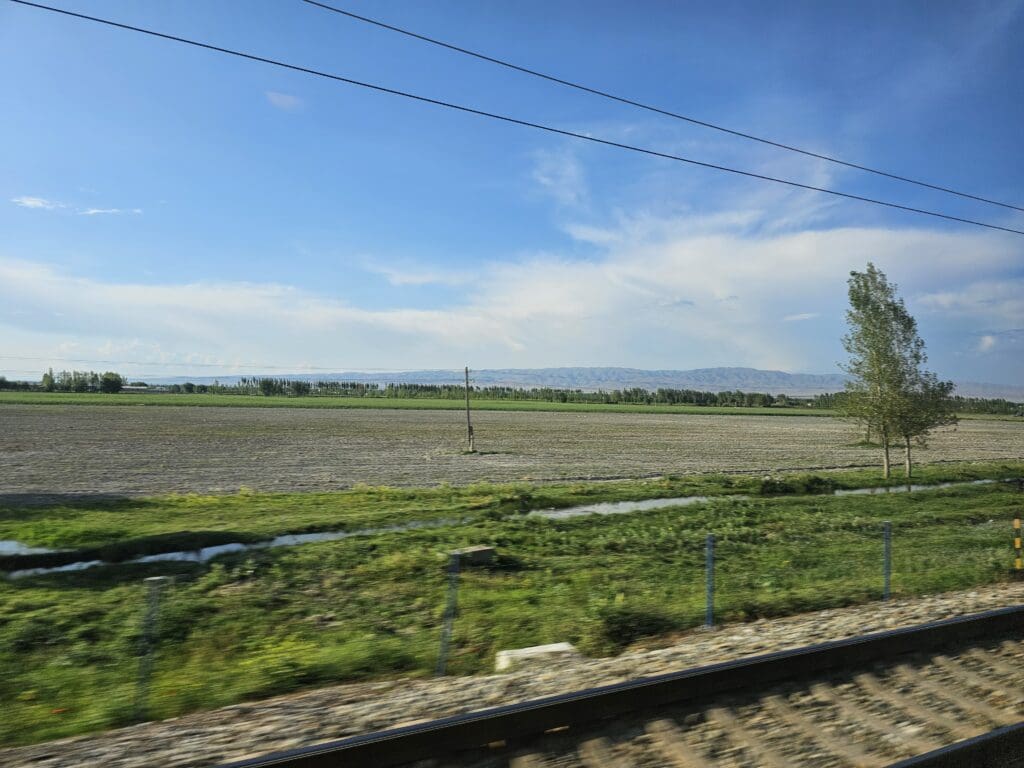
Around fifty minutes after leaving Navoi, the train could be felt slowing down as it approached the city of Samarkand – which very roughly marked the halfway point on our trek between Bukhara and Tashkent. At 1655, the pre-recorded announcement rang out advising passengers of the impending stop and we soon came to squeaky halt at Samarkand Station. There, a large and ‘beefy’ modern locomotive pulling a rake of Sharq train carriages (the seated passenger service and next fastest train after the Afrosiyob) could be seen also waiting to head to the capital. Being Uzbekistan’s second-largest city, it didn’t come as much of a surprise to find that the train appeared to completely fill up during our short stop in Samarkand and soon we continued on our journey to Tashkent.
Once away from Samarkand, one of the attendants entered the cabin juggling plastic trays, one of which was soon slapped down in front of me along with a plastic fork. Opening this up, this consisted of a simple yet adequate early dinner comprised of some chicken, white rice, a lettuce leaf, red cabbage, a slice of bread and some very dry stale-looking slices of apple and a wedge of orange. Whilst a long way from what you may expect to receive on the likes of the Orient Express, this was acceptable and I wasn’t left with too many complaints about this meal. For those who were looking for something sweet to round this off, ten minutes after this meal commenced an ice cream seller made their way through the carriage, followed by another selling fruit salads.

After polishing off my dinner, I decided to head for a short walk and trip to the bathroom which I found to be in an okay yet not particularly amazing state. Not a great deal of time, the train could be felt slowing down and the land on either side of the train rose upwards and transformed into grey rocky peaks. At this time, the train wended its way around these mountains which sit to the southeast of the city of Jizzakh before picking up speed again, reaching an impressive total of 230 kilometres per hour which we remained at for some time on our final sprint towards the capital.
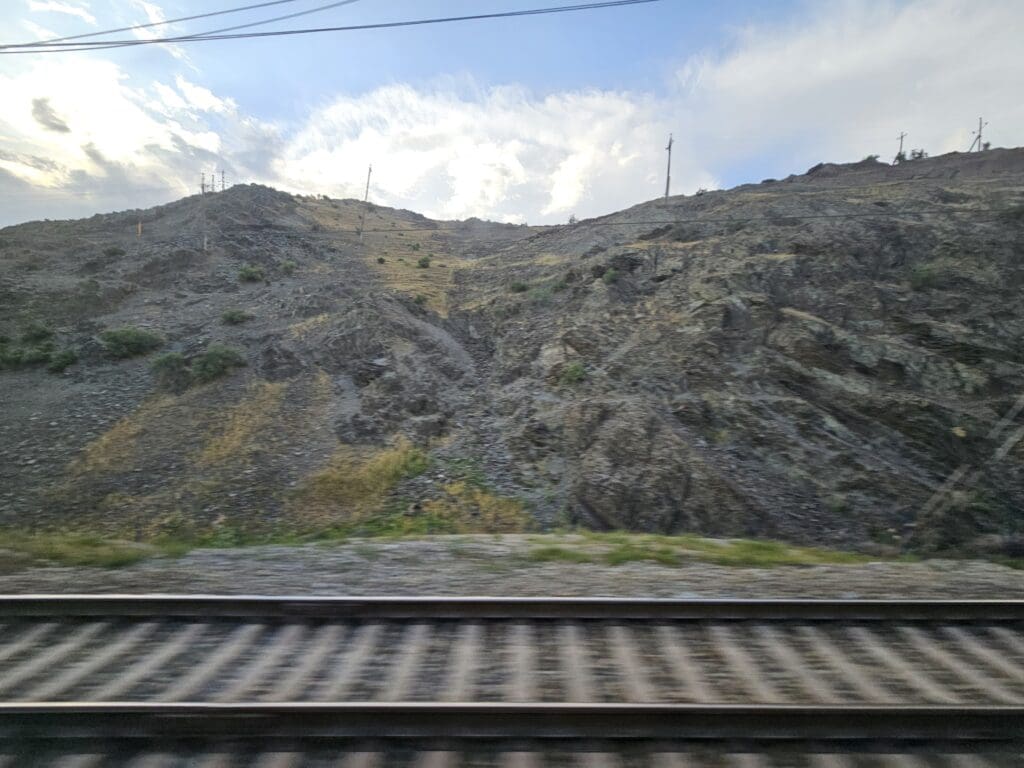
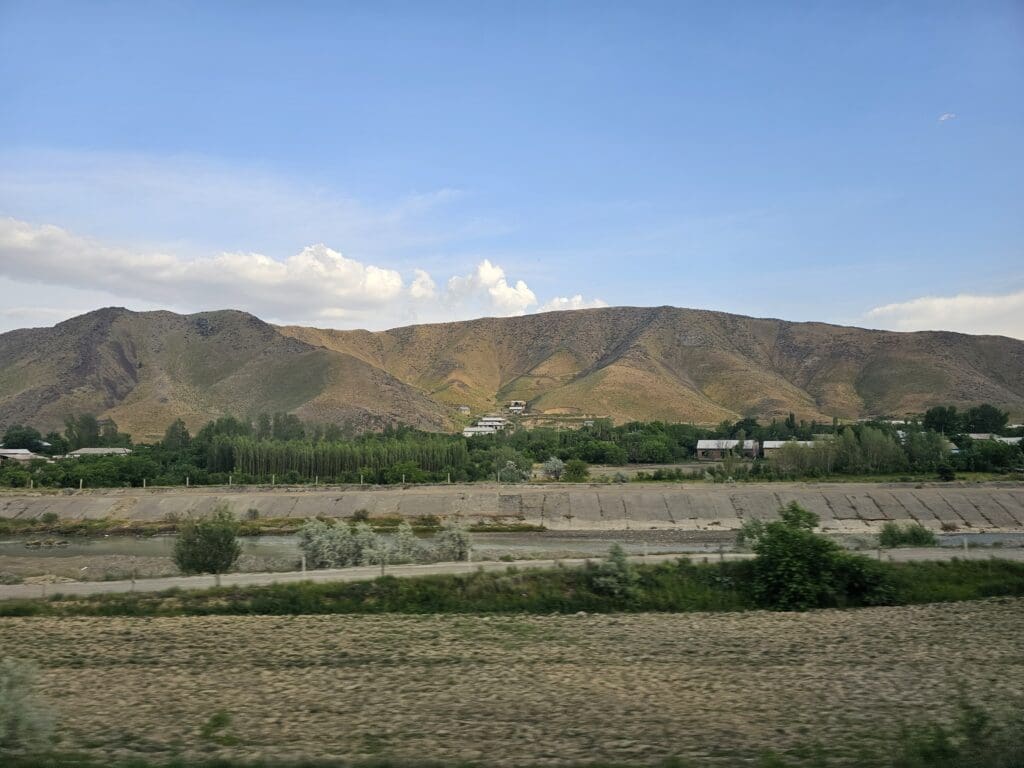
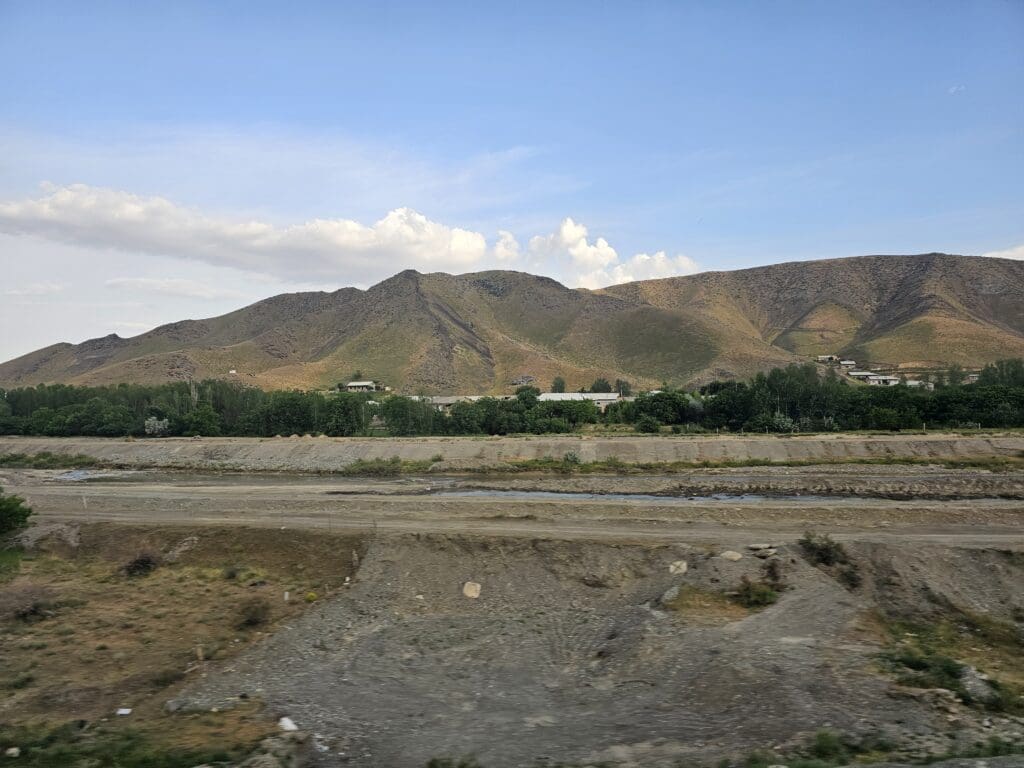
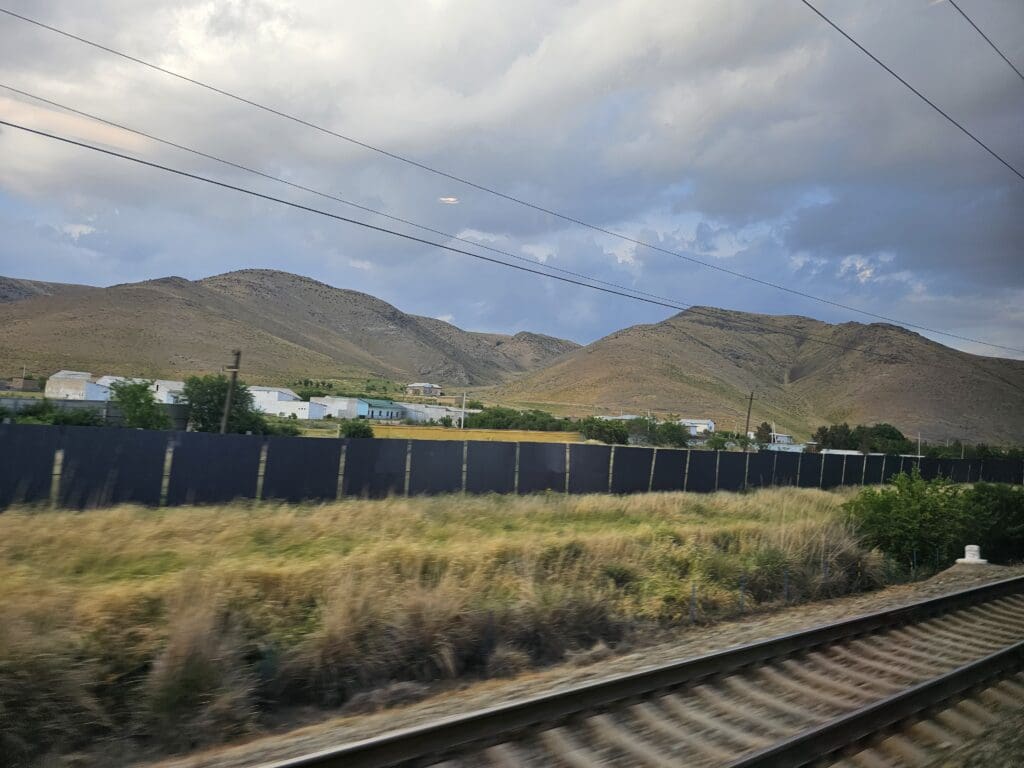

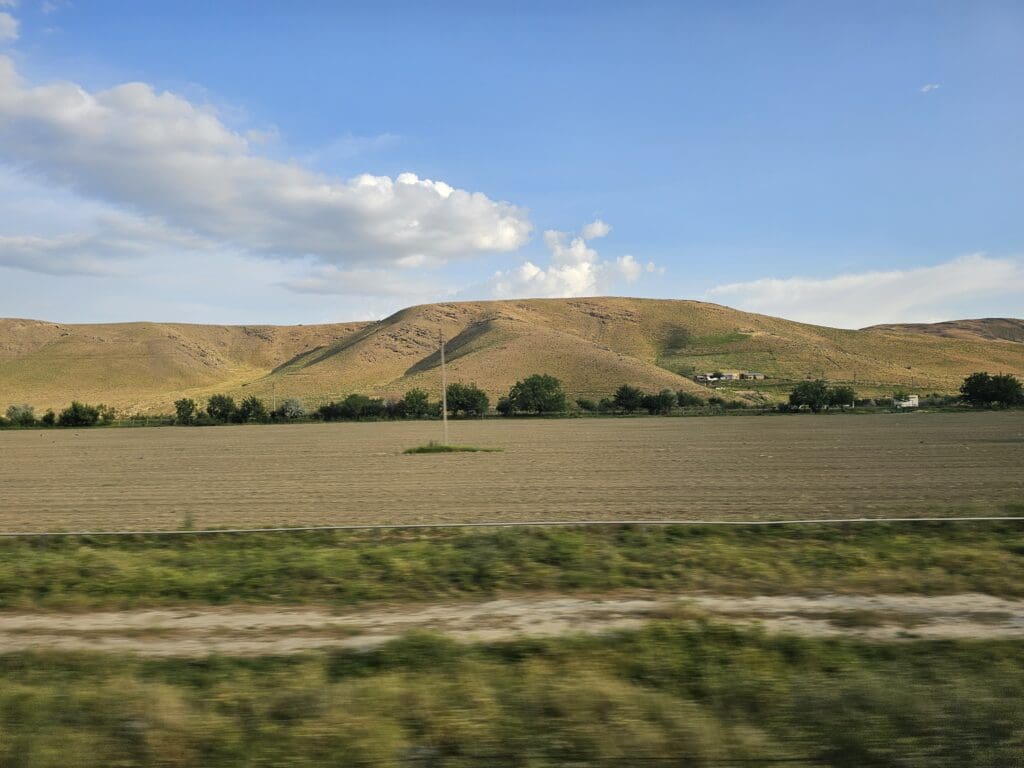
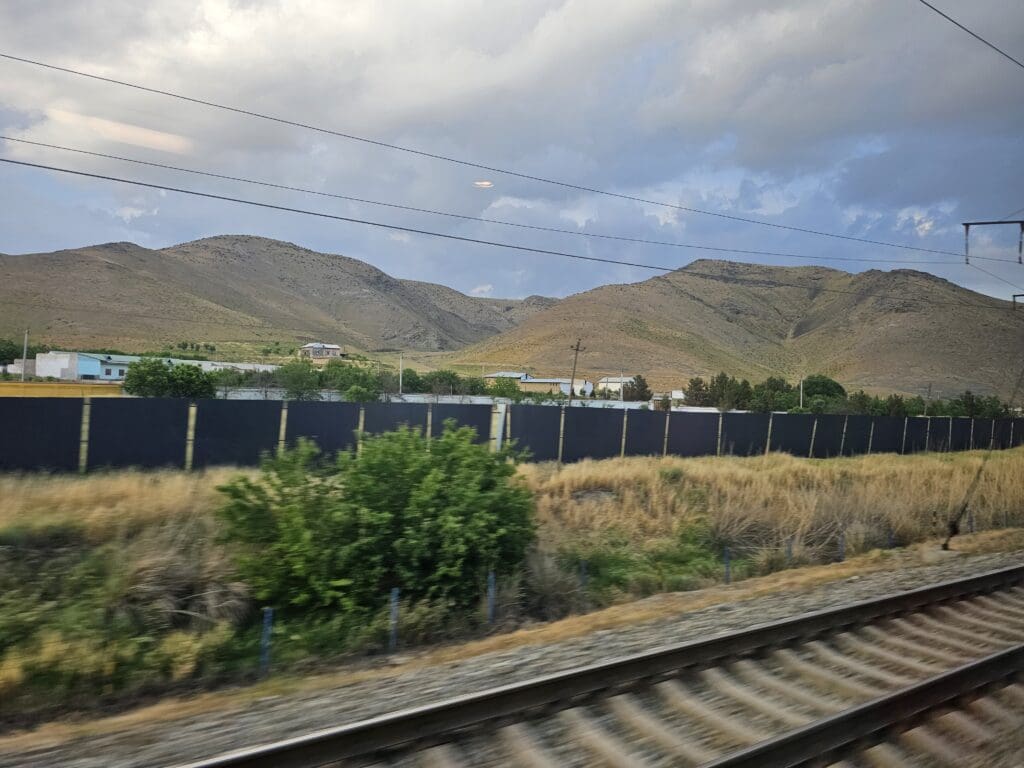
Following my trip to the bathroom, once settled down in my seat I decided to explore the onboard entertainment options. For those looking to pass the time, complimentary onboard wifi is provided although seeing as I was lacking an Uzbek phone number I ended up not being able to connect to this. I was however able to connect to the wifi-based streaming service which featured a number of Russian and Uzbek options as well as the buy-on-board menu.
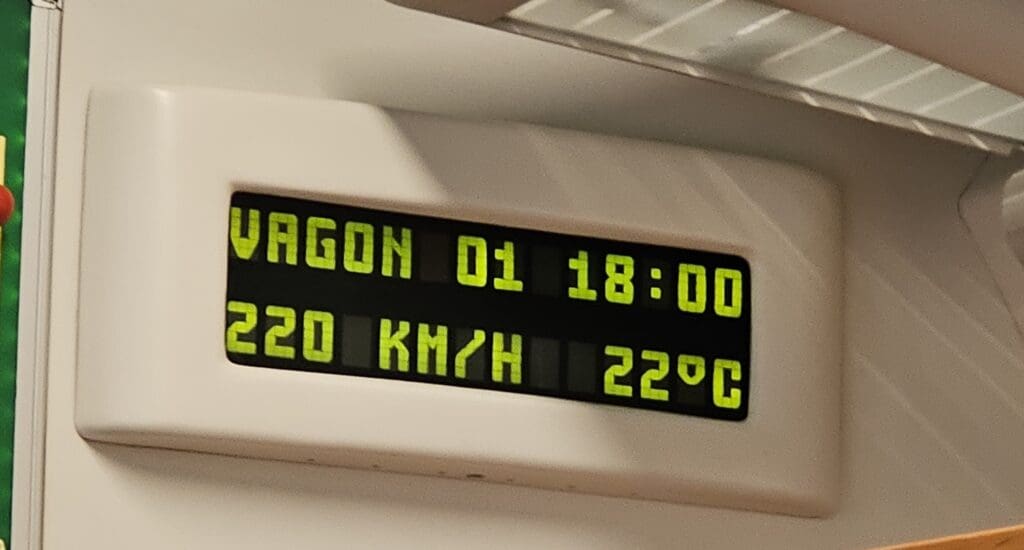
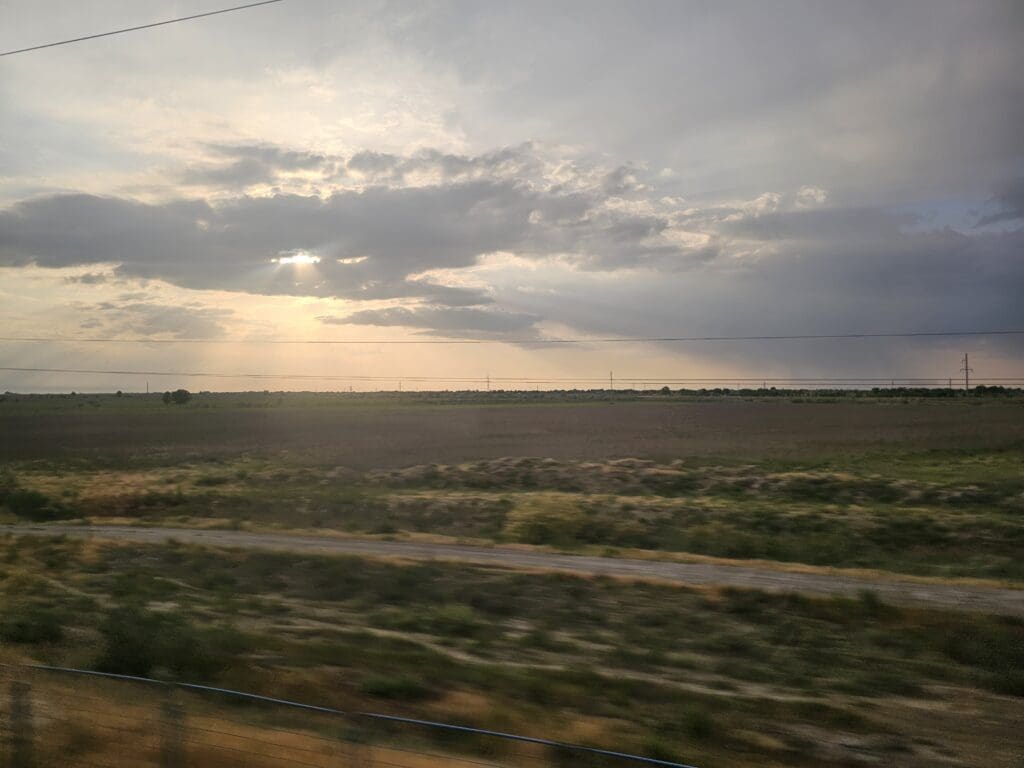
As was to be expected, as we neared Tashkent the skies darkened as evening approached and before I knew it we were speeding through the far southwestern reaches of Central Asia’s largest city. Suddenly, Tashkent’s apartment blocks appeared and we sped past Tashkent South Station where I had started my journey two days earlier. Onboard the trilingual pre-recorded announcement advising that we were nearing Tashkent loudly rang out and soon the train could be felt decelerating as it approached the terminus station. Around three hours and ten minutes after leaving Bukhara, the train slowed into the platform and came to a halt and ended its Sunday afternoon journey.
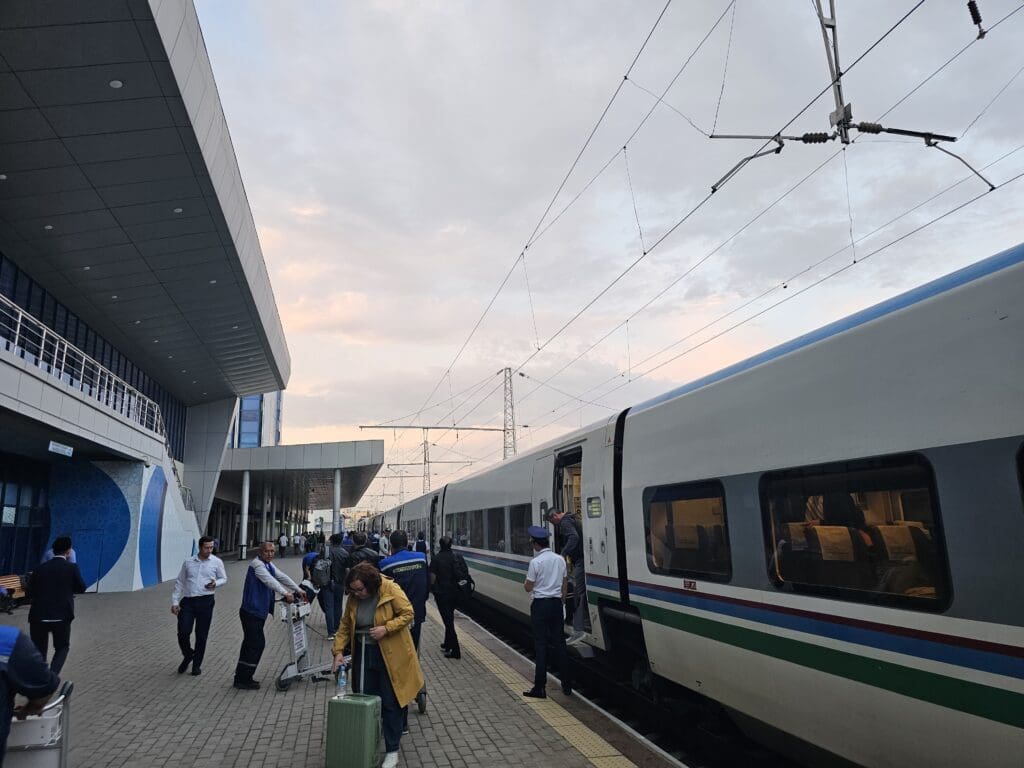
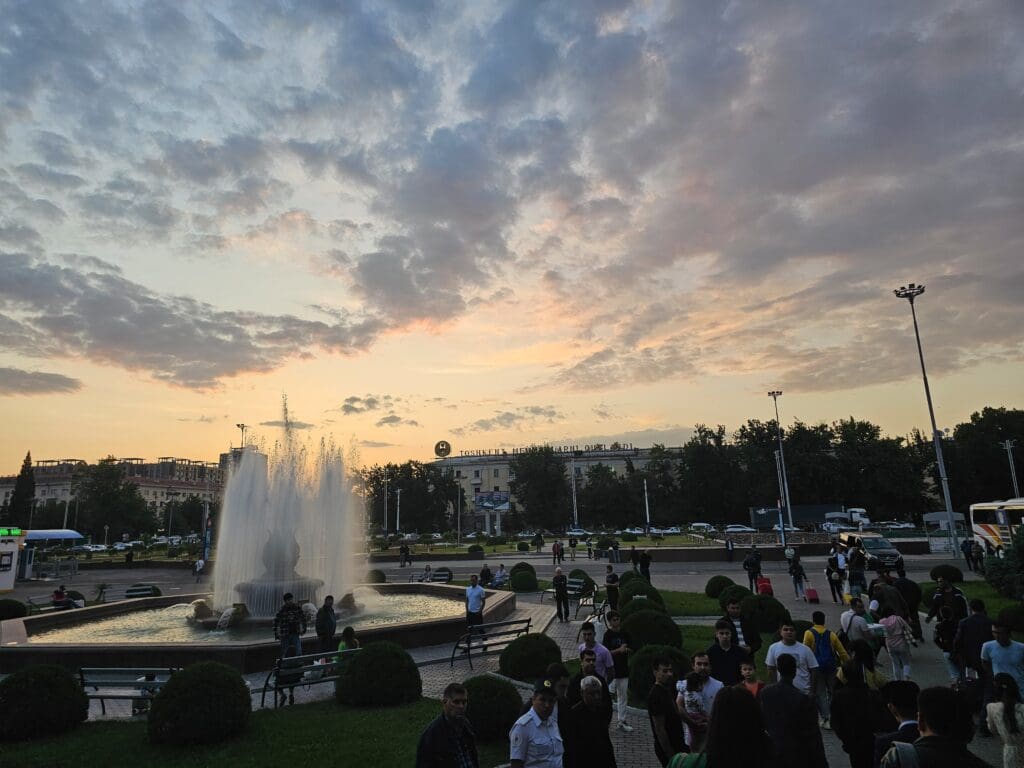
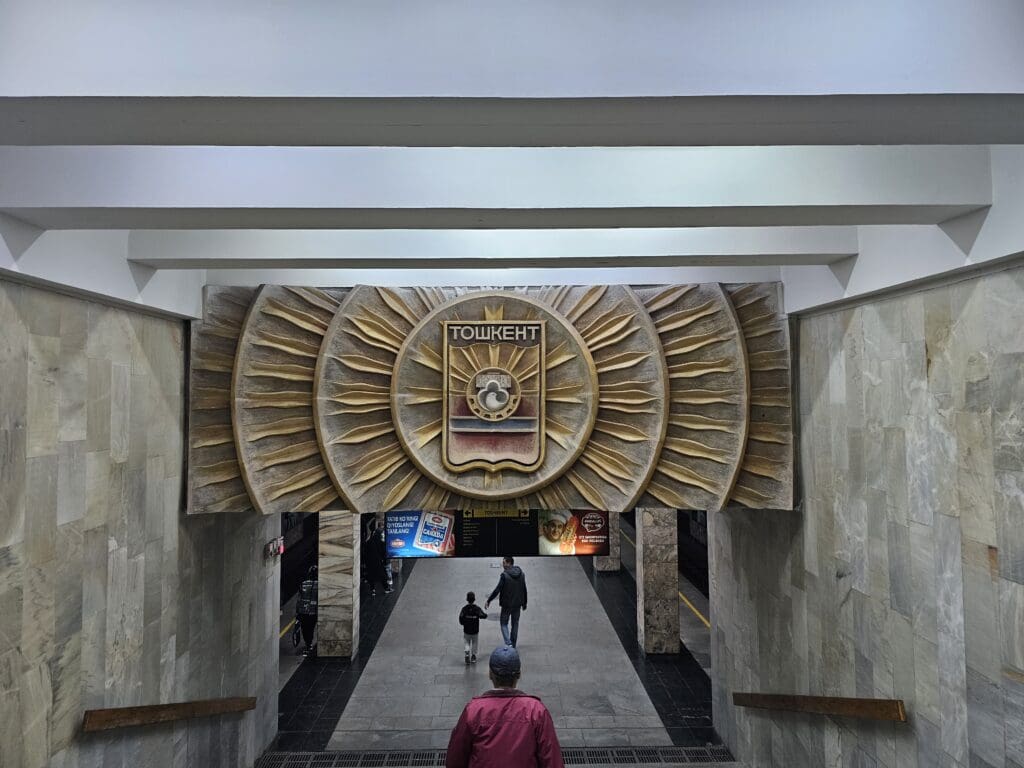
Summary
All-in-all, I had nothing negative to say about my high-speed Uzbek rail experience and would recommend this as a cheap and easy means of travelling between Tashkent and the popular cities of Bukhara and Samarkand. Whilst several airlines fly between Tashkent and Bukhara, the high-speed train is a much cheaper and easier alternative – especially if you’re heading to or from central Tashkent. Needless to say, I would not hesitate to take an Afrosiyob service again.

